Contents
Antisemitic Incidents Report January-June 2025
Executive Summary
- CST recorded 1,521 antisemitic incidents across the UK in the first half of 2025, the second-highest total ever reported to CST in the first six months of any year. This is a decrease of 25% from the 2,019 antisemitic incidents recorded by CST in the January- to-June period of 2024, which was the highest figure ever reported to CST for the first half of any year. CST recorded 965 incidents in the first six months of 2023, 823 from January to June 2022, and 1,371 in the first half of 2021.1
The 1,521 anti-Jewish hate incidents recorded in the first six months of 2025 is a fall from the half-year record reported in 2024, but it is a significant total, fuelled by ongoing reactions to the conflict in the Middle East. It is 11% higher than the third- highest six-monthly figure of 1,371 incidents recorded in 2021, which itself was a result of antisemitic reactions to an escalation of conflict in the Middle East across May and June that year. Antisemitic incidents have been reported to CST at an increased rate since the Hamas terror attack in Israel on 7 October 2023. After an immediate and notable spike in anti-Jewish hate immediately following that date, observed before Israel had coordinated any large- scale on-the-ground military response in Gaza, incident levels eventually settled at a substantially higher average than prior to the attack.
In the six months leading up to 7 October 2023, CST recorded a monthly average of 161 antisemitic incidents per month. In the first six months of 2025, this monthly average stood at 254 incidents, a 58% increase from that earlier period. CST had only ever recorded monthly incident totals exceeding 200 on five occasions prior to October 2023, each correlating with past periods when Israel was at war.Since the 7 October attack, the only month in which CST logged an incident figure below 200 was December 2024. The current war in the Middle East has lasted the entirety of the period covered in this report and has continued to impact the volume and discourse of antisemitism reported to CST in the first six months of this year, as it has every month since October 2023.

Its impact is clear in the fact that 779 incidents, 51% of the 1,521 instances of anti- Jewish hate reported to CST in the first half of the year, referenced or were linked to Israel, Palestine, the Hamas terror attack or the subsequent outbreak of conflict (all included anti-Jewish language, motivation or targeting alongside references to Israel and the conflict). A similar proportion – 52% – of incidents recorded from January to June 2024 contained this rhetoric. For comparison, in the first half of 2023, a period unaffected by a significant trigger event in the Middle East, this discourse was present in just 16% of antisemitic incidents. This shift in language is consistent with CST’s previous analyses of anti-Jewish hate in the UK when Israel is at war.
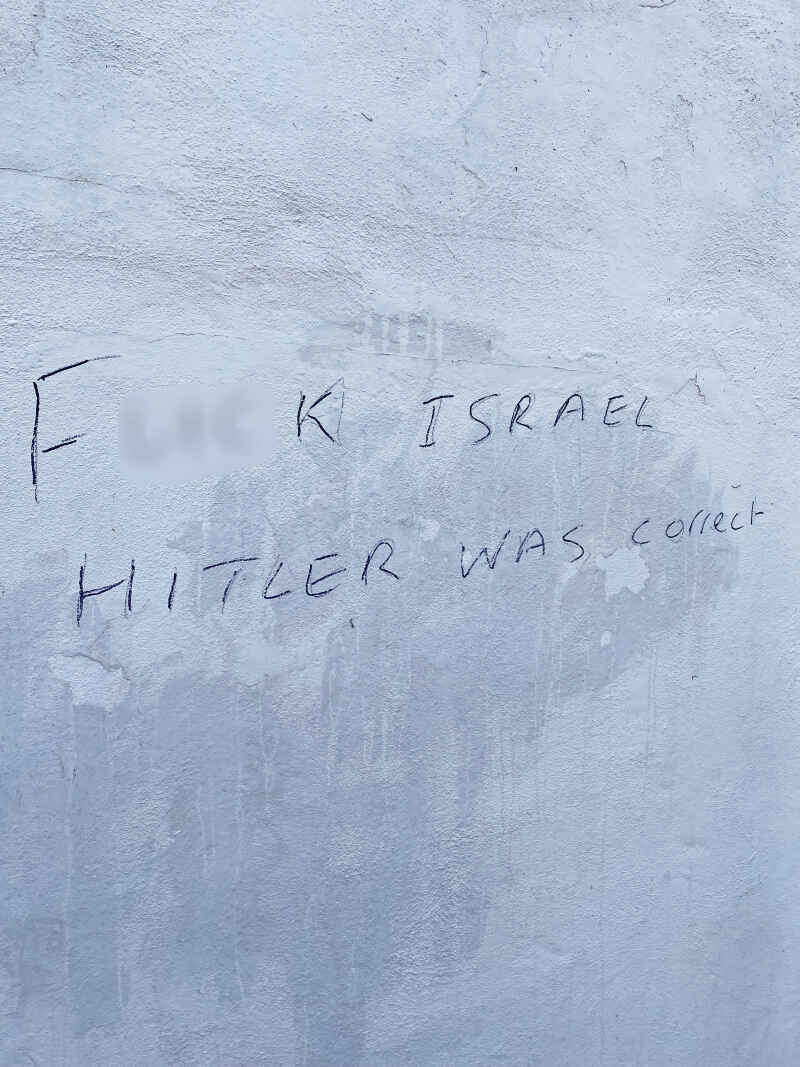
Variations on the terms “Zionism” or “Zionist” were employed on 210 occasions, often as by-words for “Jewishness” and “Jew”, or alongside other antisemitic sentiments. This was the case in 209 incidents in the first six months of 2024 (but far higher than the 47 incidents of this kind recorded in the first half of 2023). Meanwhile, there were 172 instances wherein Israel, Israelis or Jewish people were compared to Nazi Germany or the Nazis, down from 192 incidents between January and June 2024, but significantly more than the 28 such incidents recorded across the same period in 2023.
While the number of incidents involving Holocaust-related discourse fell by 7% from 513 in the first six months of 2024 to 477 between January and June this year, 107 reports involved celebration of the Holocaust, the glorification of its architects and/or their ideas, or the expressed desire for the mass industrialised extermination of Jewish people to repeat. This is more than four times as many as the 26 incidents that involved Holocaust denial or minimisation, and is an increase of 75% from the 61 incidents of this kind logged over the same timeframe last year. Of these 107 cases, 31 (29%) also referenced the Middle East, claiming that Israel has proven Hitler right about the Jews, or lamenting his failure to exterminate the entirety of the Jewish population and thereby prevent Israel’s existence and response to Hamas’ terror attack.
The enduringly high incident levels and type of content reported since the initial trigger event on 7 October 2023 partly reflect the unprecedented length of this particular war, its geographical reach from Gaza to Lebanon and Iran, and its consequent continued foregrounding in media, politics and public debate. Anti-Israel protests have persisted, as have vigils for the hostages held in Hamas captivity. Community attention to the issue of antisemitism has also been sustained at an elevated level, as has media coverage of antisemitism as an issue. These various factors have contributed to an environment wherein Jewish individuals and communities have felt more anxious, uncertain and fearful for their futures as a part of British society, knowing that they may become proxy targets for those who hate Israel, and those who use Israel as an excuse to hate Jews. As a result, they may be more motivated to report anti-Jewish hate when they see it.
In total, 1,158 (76%) of the 1,521 antisemitic incidents recorded by CST in the first half of 2025 presented evidence of one or more political or ideological discourses, motivations, anti-Jewish tropes or conspiracy theories. These narratives were reported in 1,437 (71%) of the 2,019 antisemitic incidents logged from January to June 2024, and in 516 (53%) of the 965 recorded in the first six months of 2023. This increase over the last two years further indicates the impact that conflict involving Israel has on different strands of antisemitic rhetoric in the UK. It is possible to draw a correlation between the length of this war and the likelihood that anti-Jewish hate will be flecked with political, ideological, conspiratorial and, in some cases, extremist language.
CST recorded 73 incidents in the category of Assault in the first six months of 2025, a decrease of 42% from 125 incidents of this type reported in the first half of 2024. An additional three physical attacks were deemed severe enough to be classified as Extreme Violence, up from one such incident recorded from January to June 2024. The last time CST recorded three instances of Extreme Violence in a calendar year was 2021. Taken together, these acts of violence comprise 5% of the half-year total, the lowest proportion for several years.
Cases of Damage & Desecration to Jewish property rose by 10%, from 84 in the first half of 2024 to 92 between January and June 2025, the highest ever six-monthly total in this category. Thirty-three of these involved damage done to posters, ribbons and memorials in honour of the hostages captured by Hamas, 21 to the homes and vehicles of Jewish people, 16 to synagogues, eight to Jewish businesses and organisations, three to Jewish schools, one to a kosher food aisle at a supermarket, and one to a Jewish cemetery.
There were 96 incidents reported to CST in the category of Threats in the first six months of 2025, which includes direct threats and explicit incitement of violence to people, institutions or property, as opposed to more general abuse containing non-specific threatening language. This is a fall of 34% from the 146 incidents of this kind reported from January to June 2024, making it the second-highest half-year total ever recorded in this category.
CST recorded 1,236 cases of Abusive Behaviour in the first half of 2025, the second-highest January-to-June total in this category and a decrease of 25% from the 1,649 instances of Abusive Behaviour reported over the same period in 2024. This figure alone eclipses the incident total recorded across all categories between January and June of all preceding years bar 2024 and 2021. These 1,236 incidents form 81% of the half-year total.
There were 21 incidents reported to CST in the category of mass-produced antisemitic Literature during the first six months of 2025, rising by 50% from 14 such incidents recorded across the same timeframe in 2024. Only in 2018 has CST logged more cases of anti-Jewish hate in this category over the January-to-June period.
CST recorded 572 cases of online antisemitism in the first half of 2025, 38% of the 1,521 instances of anti-Jewish hate recorded in the first half of the year. This is the highest proportion of the overall figure since the first half of 2020, when the Covid-19 lockdown restricted in-person interactions and, as a consequence, the opportunity for in-person antisemitism. It is a fall of 12% from the corresponding period last year, when 647 online incidents constituted 32% of the six-monthly total. Despite the decrease in number, the increase in percentage from the January-to-June period in 2024 reflects how antisemitism related to the subject matter of Israel continues to find oxygen on social media platforms and other virtual channels as the war goes on. This sometimes slips into antisemitic discourse. Of the 572 online incidents reported, 404 (71%) were related to events in the Middle East. This was the case in just 375 (40%) of the 949 ‘offline’ reports of anti-Jewish prejudice.
This total for online incidents is only indicative, as the actual amount of antisemitic content that is generated and disseminated on online platforms is much larger. In some cases, social media has been used as a tool for coordinated campaigns of antisemitic harassment, threats and abuse directed at Jewish public figures and other individuals. Where this is the case, CST will record a coordinated campaign as a single incident, even if it involves multiple tweets, posts, messages or comments. CST does not trawl the internet looking for online incidents to log and will only record online incidents that are reported to CST by a victim, witness or other third party, and where either the offender or the victim is based in the UK.
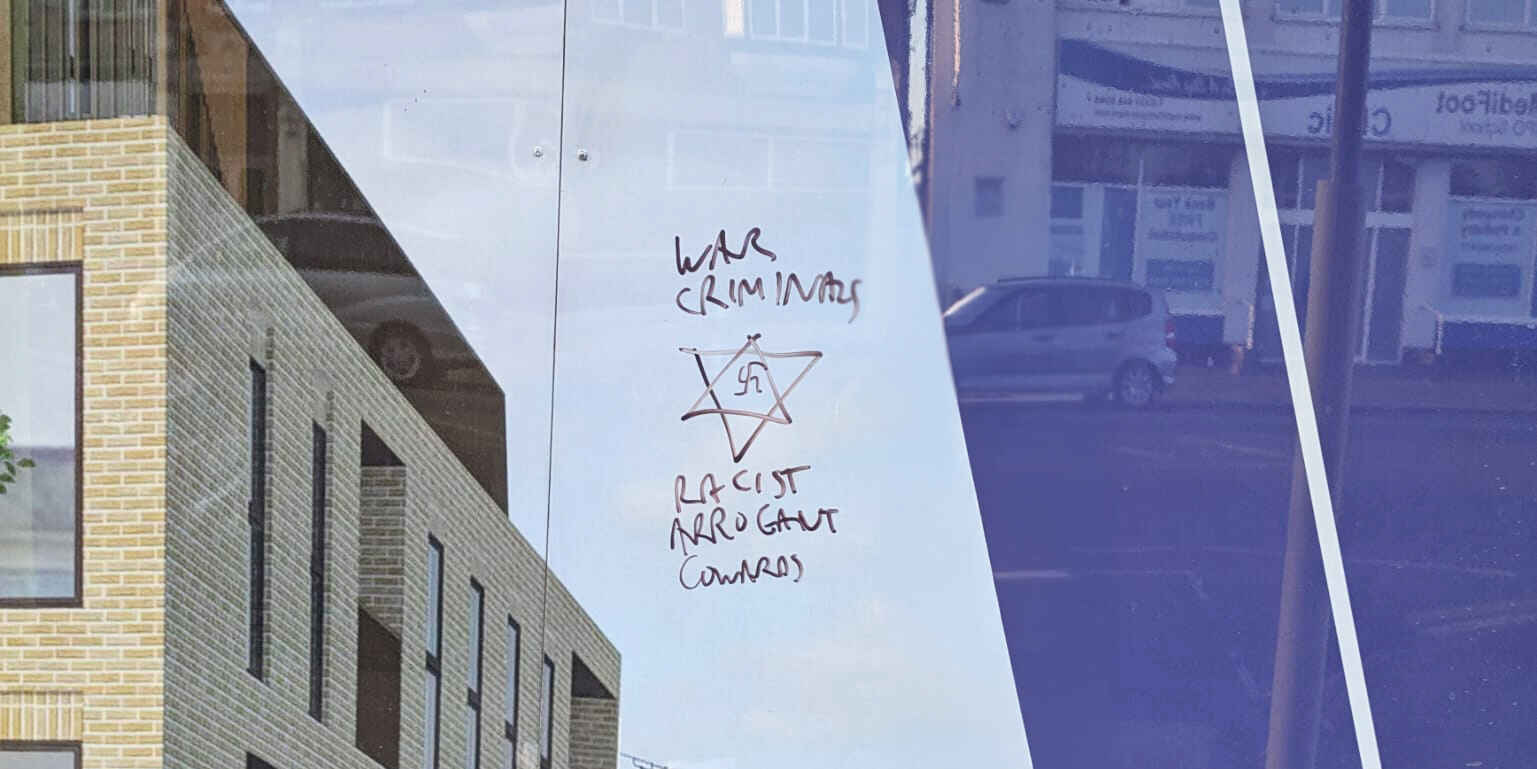
- The highest daily total for antisemitic incidents in the first half of 2025 was 26 incidents, reported on 29 June, 16 of which occurred online. These were anti- Jewish responses to events at Glastonbury Festival – where the punk-rap group Bob Vylan chanted “Death to the IDF” – and CST’s subsequent statement.2 3 The second worst day for anti-Jewish hate was 17 May when 19 incidents were recorded, 11 of which involved antisemitic placards at an anti- Israel demonstration in London that inverted the memory of the Holocaust. This was the day after Israel announced an expansion of its military operation in Gaza.4 In all of these incidents, anti-Jewish language, motivation or targeting was evident alongside the rhetoric linked to Israel or Zionism. Both of these cases illustrate how sentiment and rhetoric towards Israel and Zionism influence, shape and drive contemporary anti-Jewish discourse, online and offline, often around totemic events that grab mainstream public attention.
In the first six months of 2025, 24 antisemitic incidents were reported that took place at Jewish schools. A further 41 incidents involved Jewish schoolchildren away from school, usually commuting to or from their place of education, often visibly Jewish due to their uniform. CST logged 42 antisemitic incidents involving schoolchildren or staff at non-faith schools, comprising a total of 107 cases of anti- Jewish hate affecting people and property in the school sector. This is a decrease of 35% from the 165 school-related incidents reported from January to June 2024. Over the same timeframe in 2023, CST recorded 74 antisemitic incidents of this kind.
Thirty-five antisemitic incidents were reported to CST in the first six months of 2025 in which the victims or offenders were students or academics, or which involved student unions, societies or other representative bodies. Of these, 16 took place on campus or university property, and 13 occurred online. This is a significant drop of 64% from the 98 higher education incidents recorded in the first half of 2024, when 46 happened on campus and 46 were online. Still, this year’s total is twice the 17 such incidents that were logged across January-to-June in 2023, which was not impacted by a trigger event in the Middle East. Of the 35 cases of anti-Jewish hate logged in the university sector, 21 (60%) contained rhetoric referencing Israel and the war in the region alongside anti-Jewish language, motivation or targeting. This was the case for 51% of the incidents that were not linked to the higher education sphere.
Seventy-four antisemitic incidents during the first six months of 2025 targeted synagogues, including buildings, congregants and staff at synagogue premises. Congregants on their way to or from prayers were victims in a further 13, compared to 77 and 38 incidents respectively in the first half of 2024. This is a net fall of 24% in incidents affecting synagogues and the people travelling to, from, or already inside them, from 115 to 87 reports, still the second most ever recorded in the first half of a year. Synagogues are symbolic and often easily identifiable targets for those seeking a victim for their anti-Jewish hate.
CST obtained a description of the ethnic appearance of the offender or offenders in 588 of the 1,521 antisemitic incidents reported from January to June 2025.5 Of these, 278 (47%) were described as white – North European; 14 (2%) as white – South European; 59 (10%) as black; 81 (14%) as South Asian; four (1%) as Southeast Asian; finally, 152 (26%) were described as Arab or North African. This breakdown is close to that reported across 2024 but slightly differs from what is typically recorded during periods when anti-Jewish hate in the UK is less impacted by Middle East-related events. For comparison, in the first six months of 2023, 47% were described as white – North European; 3% as white – South European; 17% as black; 13% as South Asian; less than 1% as Southeast Asian; and 20% as Arab or North African. This shift towards a higher proportion of IC6 offenders – described as Arab or North African – is consistent with trends noted during previous periods of war involving Israel.
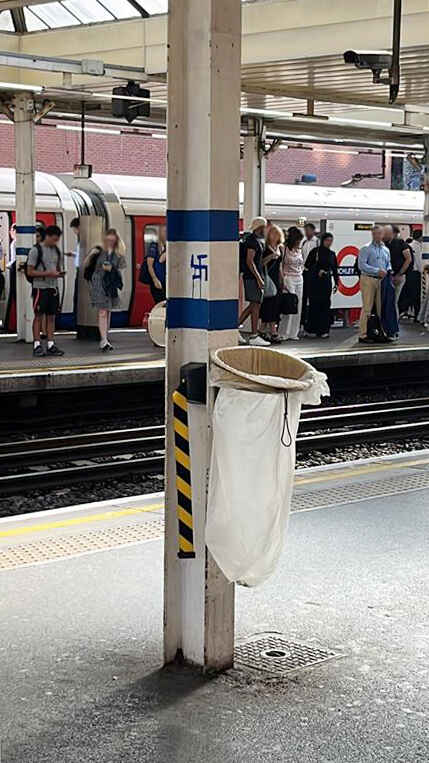
- Seven hundred and seventy-four antisemitic incidents were reported to have taken place across Greater London in the first six months of 2025, falling by 26% from 1,051 over the same timeframe in 2024. CST recorded 194 antisemitic incidents in Greater Manchester between January and June 2025, a decrease of 28% from the 270 incidents reported in the corresponding area and period last year. These figures constitute 64% of the UK’s six-monthly total, compared to 65% between January and June 2024. These communal hubs are home to the majority of the Jewish community in the UK.
Of the 774 antisemitic incidents recorded across Greater London in the first six months of 2025, 325 took place in Barnet, the local authority with the largest Jewish population in the UK. There were 95 instances of anti-Jewish hate recorded in Westminster, 79 in Camden, 34 in Hackney, and 22 in both Haringey and Harrow. The figure for Greater London would be even higher, were it not for a technical problem that has disrupted the flow of reports received from the Metropolitan Police as part of CST’s information exchange with police constabularies across the country. CST’s collaboration with police is of huge value, and remains a core component of CST’s daily work.
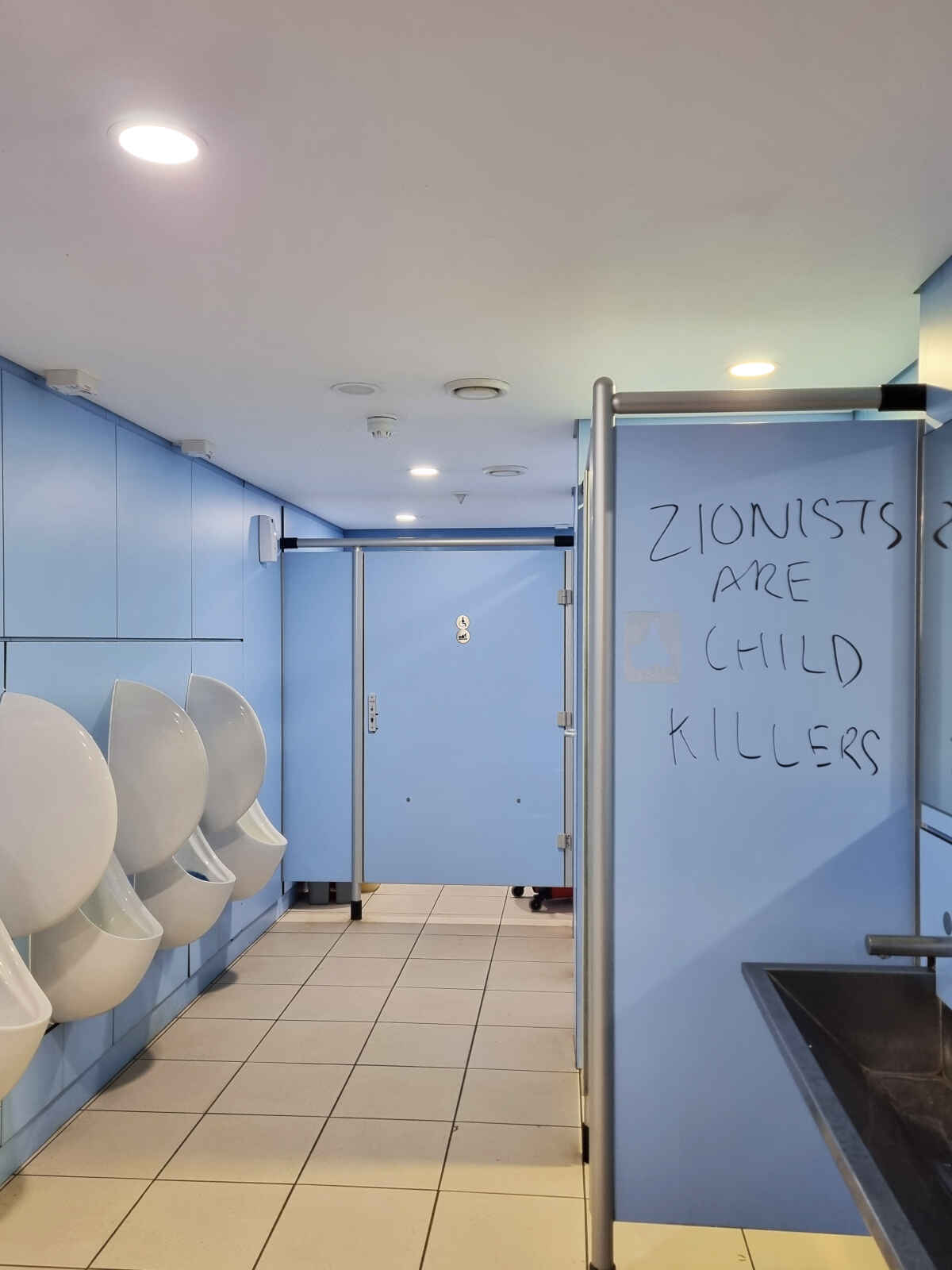
Since 7 October 2023, incident totals in Westminster have ranked higher within CST’s antisemitic incident statistics for Greater London than in previous years. While it has regularly featured in the top five London boroughs for antisemitism on account of its political significance and high footfall, it is now second only to Barnet. Part of this is because Westminster has played host to many of the capital’s anti-Israel marches, as well as vigils for the hostages in Hamas captivity and remembrance services for the victims of 7 October. While mostly peaceful events, these occasions have attracted individuals who were reported to CST for anti-Jewish placards, leaflets and hate speech. At least 33 antisemitic incidents took place in Westminster either at, or in transit to or from, anti-Israel demonstrations or vigils for the hostages. Meanwhile, 21 cases of anti-Jewish hate in the borough targeted Jewish organisations, and 13 targeted synagogues.
Of Greater Manchester’s 194 antisemitic incidents recorded between January and June 2025, 59 occurred in the City of Manchester, 50 in Bury, 41 in Salford, nine in Stockport and seven in Oldham.
The only mainland police region where CST did not record a single incident in the first six months of 2025 was Suffolk. Anti- Jewish hate exists all over the country. With the reach of social media and internet platforms, it has the potential to be seen and heard regardless of proximity to Jewish communities.
Apart from Greater London and Greater Manchester, the police regions with the highest half-year antisemitic incident figures were West Yorkshire (73 incidents, compared to 119 in the same timeframe in 2024); Hertfordshire (52 incidents, compared to 65 in the first half of 2024); West Midlands (39 incidents, decreasing from 45 in the first six months of 2024); Scotland (36 incidents, down from 41 between January and June 2024); and Sussex (32 incidents, rising from 27 in the first six months of 2024).6
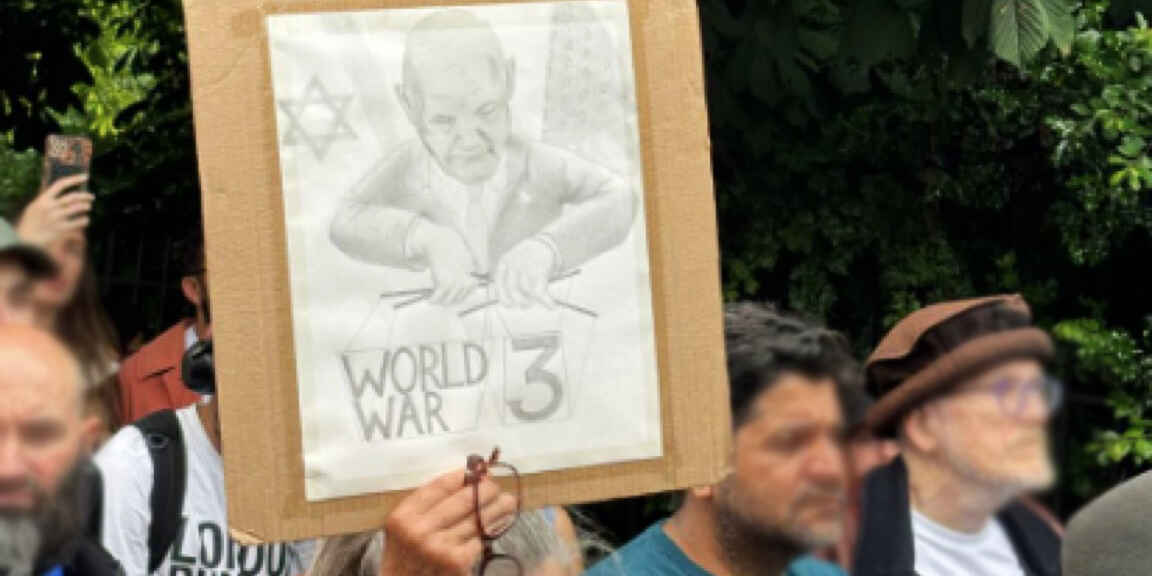
Other than Greater London and Greater Manchester’s boroughs, the towns and cities with the highest number of reported antisemitic incidents from January to June 2025 were Leeds in West Yorkshire (45 incidents); Birmingham in West Midlands (31 incidents); Borehamwood & Elstree in Hertfordshire (29 incidents); Liverpool in Merseyside (28 incidents); and Brighton & Hove in Sussex (20 incidents).
In addition to the 1,521 antisemitic incidents recorded in the first six months of 2025, a further 1,081 potential incidents were reported to CST that are not included among the report’s statistics as, upon further investigation, they did not evidence antisemitic language, motivation or targeting. Many of these potential incidents involve suspicious activity or possible hostile reconnaissance at Jewish locations, and they play an important role in informing CST’s provision of protection to the Jewish community.Others involve anti-Israel activity that did not include anti-Jewish language or targeting. It is the second-highest number of non-antisemitic incidents that CST has ever recorded in the first half of a year, after the 1,405 such incidents logged between January and June 2024, and it partly conveys the ongoing high levels of anti-Israel (but not antisemitic) rhetoric observed since 7 October 2023. It also reflects a Jewish community that has consequently felt an intensified sense of anxiety and has thus been more inclined to report any perceived hostile activity.
Antisemitic Incident Numbers
CST recorded 1,521 antisemitic incidents across the UK in the first six months of 2025, the second-highest total ever reported to CST in the January-to-June period of any year.
This figure constitutes a decrease of 25% from the 2,019 antisemitic incidents recorded in the first half of 2024, which remains the highest total ever reported to CST between January and June. CST received 965 reports of anti-Jewish hate in the first six months of 2023, 823 in the first half of 2022, and 1,371 from January to June 2021.
In addition to the 1,521 antisemitic incidents recorded in the first six months of 2025, a further 1,081 possible incidents were reported that are not among the statistics analysed in this report because, upon examination, they did not evidence antisemitic motivation, language or targeting. These other reports, forming 42% of the 2,602 potential incidents reported to CST, involved suspicious activity or possible hostile reconnaissance at Jewish locations, non-antisemitic crime affecting Jewish people or property, or anti-Israel activity that did not meet CST’s threshold for classification as antisemitic. Although not included in this report’s data, many of these non-incidents are nonetheless relevant for CST’s provision of security protection to the Jewish community. Many required further investigation or a security-related response.
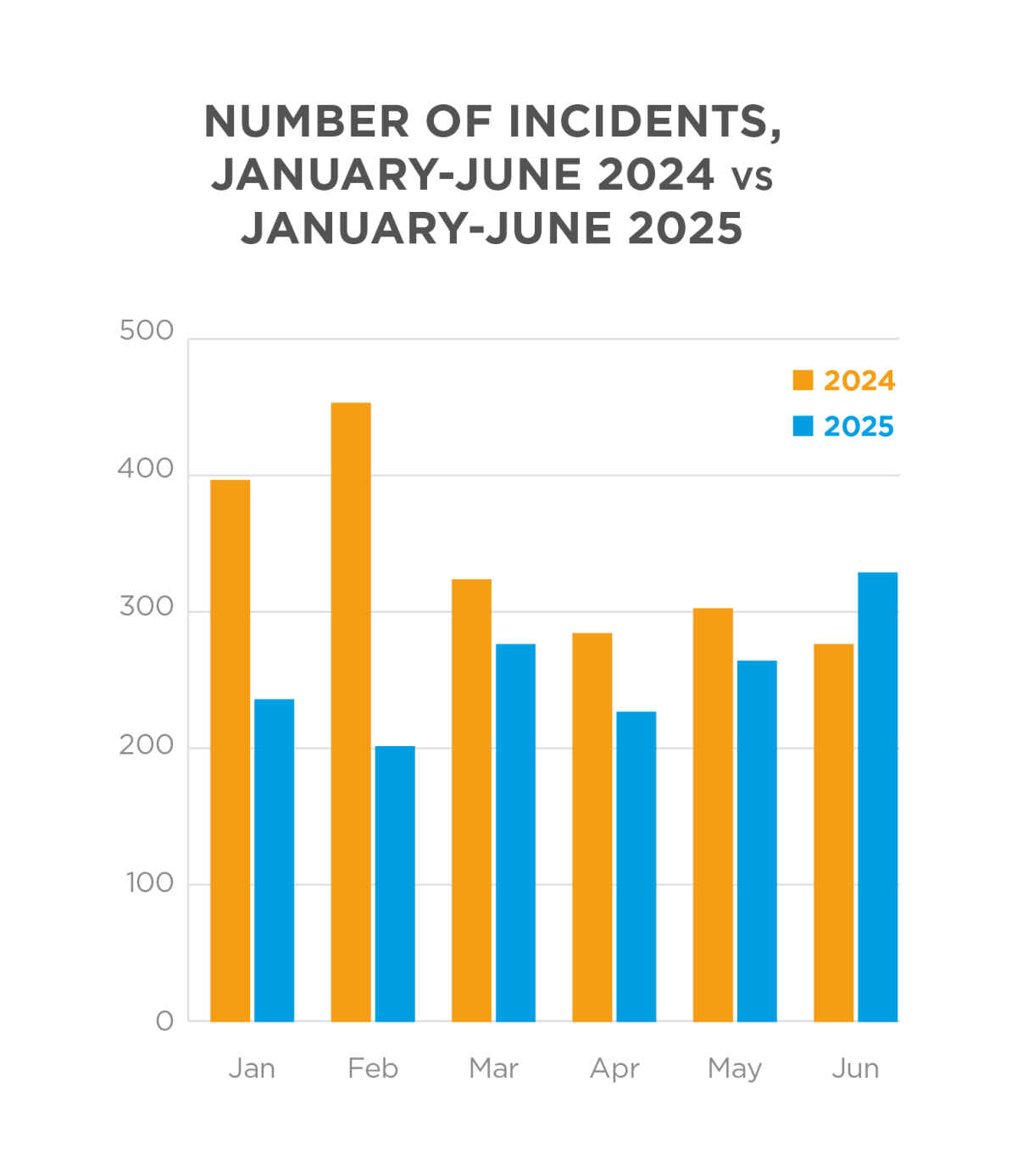
The half-year figure of 1,521 antisemitic incidents, while less than the one reported i2024, is still significant. The decrease of 25% reflects the unprecedentedly high total of antisemitism reported from January to June 2024, which was influenced by the immediate aftermath of the 7 October attack. Taking a longer view, the total for the first half of 2025 is still historically high. It is 11% higher than the third-highest January-to-June total recorded in 2021, when the volume of anti- Jewish hate in the UK was a consequence of reactions to an escalation in the conflict between Israel and Hamas in May and June that year. Ever since Hamas’ terror attack on Israel on 7 October 2023, antisemitic incidents have been reported to CST at an increased rate. There was an instant, dramatic spike, before Israel had initiated any extensive military ground incursion in Gaza. As the war continued, incident levels eventually settled, but did so at a much higher average than typically logged before the attack, with events in the Middle East influencing both the quantity and composition of anti-Jewish hate throughout this time.
Over the first half of this year, CST recorded an average of 254 incidents per month, a 58% rise from the monthly average of 161 incidents reported to CST across the six months prior to 7 October 2023. From January to June 2025, and in every month since October 2023 bar December 2024, CST recorded monthly totals surpassing 200 incidents. Before October 2023 this had only happened on five occasions, each coinciding with periods of conflict involving Israel.
The worst month for antisemitism in the first half of 2025 was June, with 326 incidents. This was also the month with the highest total for antisemitic incidents containing language referencing Israel and the Middle East, which was present in 200 incidents, and the month wherein incidents of this kind formed the highest proportion of the monthly total (61%). It was in June that Israel and Iran were engaged in warfare for 12 days, and when chants of “Death to the IDF” at Glastonbury Festival generated a lot of public discourse, some of which was antisemitic.7 Indeed, the highest daily total for antisemitic incidents in the first half of 2025 was 26 incidents, reported the day after these chants (29 June). Sixteen of these took place online and were anti-Jewish reactions to these events and CST’s subsequent statement. However, incident levels had already started to increase in May following the bombing of the Gaza European Hospital on 13 May. Prior to this airstrike, May’s average daily total for anti-Jewish hate incidents was seven, but rose to ten for the rest of the month. The second- highest daily total was reported on 17 May, when 19 incidents were recorded. On this day, there was a large anti-Israel protest in London at which 11 separate placards were logged that compared Israel to Nazi Germany. This march took place the day after Israel announced an expansion of its military operation in Gaza.
Meanwhile, the month with the fewest instances of anti-Jewish hate was February, with 200 incidents reported. This was also the month with the lowest total for antisemitic incidents containing language referencing Israel and the Middle East, which was present in 83 incidents, and the month wherein incidents of this kind formed the lowest proportion of the monthly total (42%). February was the only month during the entirety of which Israel and Hamas observed a ceasefire, beginning on 19 January and ending on 18 March.8
The monthly averages recorded since October 2023, and the fluctuations within that timeframe, demonstrate how contemporary anti-Jewish hate is in part shaped by a contempt for Israel and responds to events – or a lack thereof – in the Middle East.
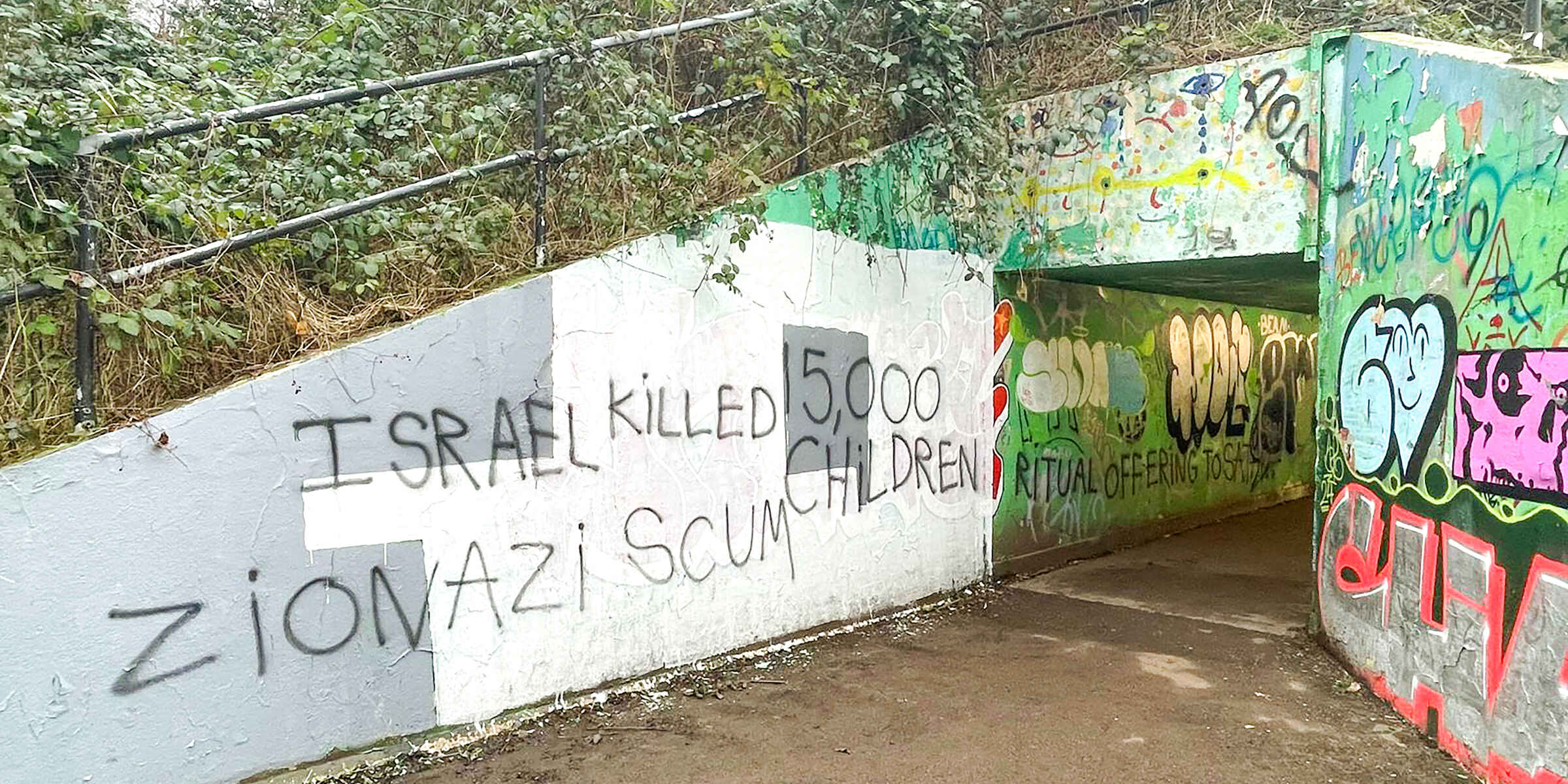
This particular war has lasted longer than any previous iteration this century and has spanned from Gaza to Lebanon and Iran. Its scope and duration have in turn drawn protracted focus in the news and public discussion, with images of war, hostages, violence and devastation permeating in media, broadcast and social. Demonstrations against Israel and vigils for Hamas’ victims and hostages have persisted, while the topics of antisemitism and the safety of Jews have also held increased prominence in the media, as well as within community circles.
These circumstances tend to correlate with high levels of anti-Jewish hate, in part because they contribute to the augmented feelings of anxiety, uncertainty and fear that the Jewish community has widely felt since 7 October 2023 that they may be targeted by people who hate Israel, Jews or both. These feelings probably lead to an increased motivation to report antisemitic incidents as and when they occur.
The ongoing influence of the conflict in the Middle East on anti-Jewish hate in the UK is clear in the 779 incidents – 51% of the half-year total – that involved rhetoric or were otherwise linked to Israel, Palestine, the Hamas terror attack or ensuing war. This is similar to the proportion of incidents recorded from January to June 2024 that contained this discourse – 52% – and is far higher than the 16% of Israel-related reports in the same timeframe in 2023, which was not significantly impacted by a trigger event in the region. This context also affected the volume, percentage and content of online antisemitism logged by CST in the first six months of the year. CST recorded 572 online instances of anti-Jewish hate, 38% of the January-to-June figure. Although a fall of 12% from the first half of 2024, when 647 online incidents comprised 32% of the total, it is the largest proportion of the overall count since the first six months of 2020, when national lockdowns reduced the opportunity for face- to-face interactions and, by extension, face-to-face antisemitism.
Seventy-one per cent (404 incidents) of the 572 cases of online anti-Jewish hate employed narratives regarding Israel and the Middle East, compared to 40% (375 incidents) of the 949 reports of antisemitism that took place ‘offline’. The disparity between the two highlights the prevalence of the topic in online antisemitic incidents. Meanwhile, at least one political, religious and antisemitic discourse, conspiracy theory, trope or ideology was found in 516 (90%) of the online incidents and 642 (68%) of the ‘offline’ incidents. Both are high percentages, but virtual spaces are proportionally more prone to hosting politicised and extremist prejudice against Jewish people. They provide room for antisemites to meet like-minded peers, have their hatred validated and amplified, and spread it with anonymity and abandon, too often without meaningful punishment from those responsible for moderating these platforms.
There were 285 antisemitic incidents reported that took place on X; 86 on Facebook; 53 on text or instant messaging services, including those associated with social media platforms; 48 via email; 44 on Instagram; 12 on TikTok; two on YouTube; one on Snapchat; one involved the hacking of a non-Jewish organisation’s website to share an antisemitic video; and 40 occurred on a range of other virtual sites. These figures only reflect the number of reports to CST involving each platform or medium, rather than being an assessment of the relative amount of antisemitism on each.
Five hundred and thirty-four of the 572 online cases of anti-Jewish hate reported in the first six months of 2025 fell into the category of Abusive Behaviour, while 32 were classed as Threats, and six as antisemitic Literature. In 99 of these posts, the offender included antisemitic memes, images, graphics or cartoons.
CST records each specific targeted campaign as a single incident, because to record each piece of antisemitic online content as a separate incident would be unsustainable and cause extreme variations in CST’s incident totals, obstructing clear analysis. It is also worth bearing in mind that the number of online incidents in this report reflects the number of reports received by CST from victims, witnesses or other third parties, and does not include the vast amount of antisemitic material unearthed, sifted and investigated by CST’s researchers as part of its wider work protecting the Jewish community from potential attack. Given the vast array of material posted and the variety of platforms across which it is circulated, an accurate figure for the actual amount of antisemitic content on social media would be impossible to quantify. Instead, this total highlights that online platforms continue to be a fertile ground for public expressions of antisemitism, sometimes culminating in coordinated campaigns against Jewish public figures and institutions.
It is sometimes difficult to gauge whether these historically high antisemitic incident figures observed by CST are due to more incidents taking place in the UK, or the fact that people feel more comfortable, able and aware to report incidents to CST. The answer is likely to be a combination of both, although sometimes, as in the aftermath of Hamas’ terror attack on Israel, it is clear that there has been a genuine rise in anti-Jewish hate that is initiated by a specific set of circumstances. A less tangible factor behind the general increase observed is the possible impact that the prevalence of increased antisemitism, and media coverage and public debate about the subject, may inadvertently have on actual hate actors. If there is a perception that the taboo against articulating hostility about or towards Jewish people is weakening, then antisemites might feel that they are far from alone in this prejudice, and be more likely, perhaps, to have confidence in sharing their views.
Despite improvements in reporting, it is expected that antisemitic hate crimes and hate incidents are underreported, especially where the victims are minors or the incident is considered of ‘lesser’ impact by the victim. The statistics contained in this report should therefore be seen as indicative of general trends, rather than absolute measures of the number of incidents that took place. Answering why antisemitic incidents take place is not simple. Victim or witness evidence for what may have been a brief, traumatic experience can be vague and disjointed. Many incidents do not have a specific victim and the offender is often unknown, but it is still possible to analyse the data contained in the individual reports received by CST, and the picture they show is complex. In short, there is no single profile of an antisemitic incident victim or offender, nor is there a single explanation as to why antisemitism persists in modern society.
Antisemitic or anti-Israel?
CST is often asked about the difference between antisemitic incidents and anti-Israel activity, and how this distinction is made in the categorisation of incidents. The distinction between the two can be subtle and the subject of much debate. Clearly, it would not be acceptable to define all anti-Israel activity as antisemitic. Nevertheless, it cannot be ignored that contemporary antisemitism can occur in the context of, or be accompanied by, extreme feelings over the Israel/Palestine conflict, and that hostility towards Israel may be expressed via, or motivated by, anti-Jewish rhetoric, stereotypes and conspiracy theories. Discourse relating to the conflict is used by antisemitic incident offenders to abuse Jews, and anti-Israel discourse can sometimes repeat, or echo, antisemitic language and imagery. For example, the terms “Zionist” and “Zionism” will often be used in arguments about Israel and the Middle East; sometimes they are used accurately and legitimately, and at other times they are deployed in an antisemitic way. CST must distinguish between the occasions when these terms are used in a purely political sense, and the times when they are abused as euphemisms for “Jews” and “Jewishness”. Similarly, the phrases “Zionist Lobby” and “Israel Lobby”, when they are deployed indiscriminately as a label for Jewish organisations and individuals regardless of whether they are relevant to the matter being discussed, connect the conspiracy theory that Jews have a disproportionate political power and influence, with the antisemitic trope that Jews are not to be trusted. Drawing out these distinctions, and deciding on where the dividing lines lie, is one of the most difficult areas of CST’s work in recording and analysing hate crime.
Sometimes the targeting of a particular incident can suggest an intention to intimidate or harass Jews on the part of the offender. For example, if anti-Israel posters or graffiti appear to have been deliberately placed close to a synagogue or other Jewish building, or in an area with a large Jewish population, then they are more likely to be classified as an antisemitic incident than if they are placed in a more general or neutral location. If anti-Israel material is sent unsolicited to a synagogue or other clearly Jewish venue at random then it may well be recorded as an antisemitic incident (because the synagogue was targeted on the basis of it being Jewish and the offender has failed to distinguish between a place of worship and an organisation involved in pro-Israel political activity). Similarly, if cars draped in Palestinian flags are deliberately driven through the heart of Jewish communities, or shouts of “Free Palestine”, or comments and questions demanding an opinion on the Middle East are directed at Jewish people – simply because they are perceived to be Jewish – it will also be considered an antisemitic incident.
If, however, anti-Israel material (containing no antisemitic language) is sent unsolicited to specifically pro-Israel organisations, then this incident would not be classified as antisemitic. Similarly, if a Jewish individual or group engaging in public pro-Israel advocacy subsequently receives anti-Israel material, comments or questions, this would most likely not be classified as antisemitic (unless, again, it contains antisemitic language).
The political discourse used in an incident may also be the reason why it is accepted or rejected as antisemitic. In particular, incidents that equate Israel to Nazi Germany would normally be recorded as antisemitic because the comparison is so deeply hurtful and abusive, using Israel’s self-definition as a Jewish state, and the Jewish identity of the Holocaust’s primary victims, as the basis for the insult. This analogy, made with increasing regularity since 7 October 2023, is reflected in changes to anti-Jewish language, such as in the neologism “Zionazi”. However, language that compares Israel to, for example, apartheid South Africa would not normally be recorded as an antisemitic incident by CST, nor would claims that Israel is committing a genocide in Gaza (unless allusions are directly made to the genocide carried out by the Nazis). While the charges that Israel practises apartheid or carries out genocide upset many Jews, they do not contain the same visceral capacity to offend as the comparison with Nazism, which carries particular meaning for Jews because of the Holocaust; nor do they play directly and explicitly on Israel’s Jewishness as a way of causing hurt.

CST recorded 779 antisemitic incidents that referenced or were related to Israel, Palestine and the war in the Middle East from January to June 2025. Seven hundred and three incidents evidenced anti-Zionist political motivation that went beyond more superficial discourse about the region or the conflict, alongside explicitly antisemitic comments or abuse aimed at unsuspecting Jewish people. The terms “Zionist” or “Zionism” were employed in 210 instances, while the offender made a direct comparison between Israel and the Nazis on 172 occasions.
Irrespective of whether or not anti-Israel incidents are classified as antisemitic by CST, they are still relevant to CST’s victim support and security work as they may involve threats and abuse directed at Jewish people or organisations whose work is related to Israel, and therefore have an impact on the safety of the UK Jewish community.

Incident Categories
Extreme Violence 9
CST recorded three incidents of Extreme Violence in the first six months of 2025, compared to one in the first half of 2024, none in the first six months of 2023 and 2022, and two between January and June 2021. One of these attacks involved a bottle, one involved a box-cutter, and one involved a hammer. The last time CST recorded three instances of Extreme Violence in a calendar year was 2021.
Assault
CST recorded 73 incidents in the category of Assault during the first half of 2025, a decrease of 42% from the 125 incidents of this kind reported in 2024. There were 86 Assaults reported from January to June 2023, 75 in the first half of 2022, and 89 in the first six months of 2021. It is notable that, even though the overall incident total for January to June 2025 is higher than the same period in every year bar 2024, the number of violent incidents (combining Assault and Extreme Violence) is lower than in 2023 and 2021, and almost the same as in 2022. In 20 violent incidents in the first half of 2025, the victim was punched or kicked, and in 15 instances, the offender threw eggs, stones, bricks or other objects – including one ham sandwich – at the victim, launching them from a passing vehicle on six occasions. Seven attacks involved spitting, five involved the use of various objects as weapons, while in four incidents, the offender stripped the victim of religious clothes or accessories. There were two instances wherein a vehicle was used to endanger pedestrians, one in which the perpetrator attempted to break a car window onto the victim inside, one attack employing a non-lethal firearm, and one where the victim’s hair was set alight. Fifty-five of these violent incidents were accompanied by verbal abuse, and 11 contained an element of intimidatory language.
Taken together with the incidents of Extreme Violence, physical attacks on Jewish people comprise 5% of the overall antisemitic incident total reported from January to June 2025, down from 6% in the corresponding period last year. In the first six months of 2023, violent incidents constituted 9% of the overall figure, with the proportional drop starting in the aftermath of 7 October that year. It suggests that the subsequent sustained high levels of anti-Jewish hate in the UK, prompted in the main by an anger towards Israel, has been expressed at a higher rate through antisemitic verbal or written abuse, threats and vandalism, and less frequently through acts of physical force than before.
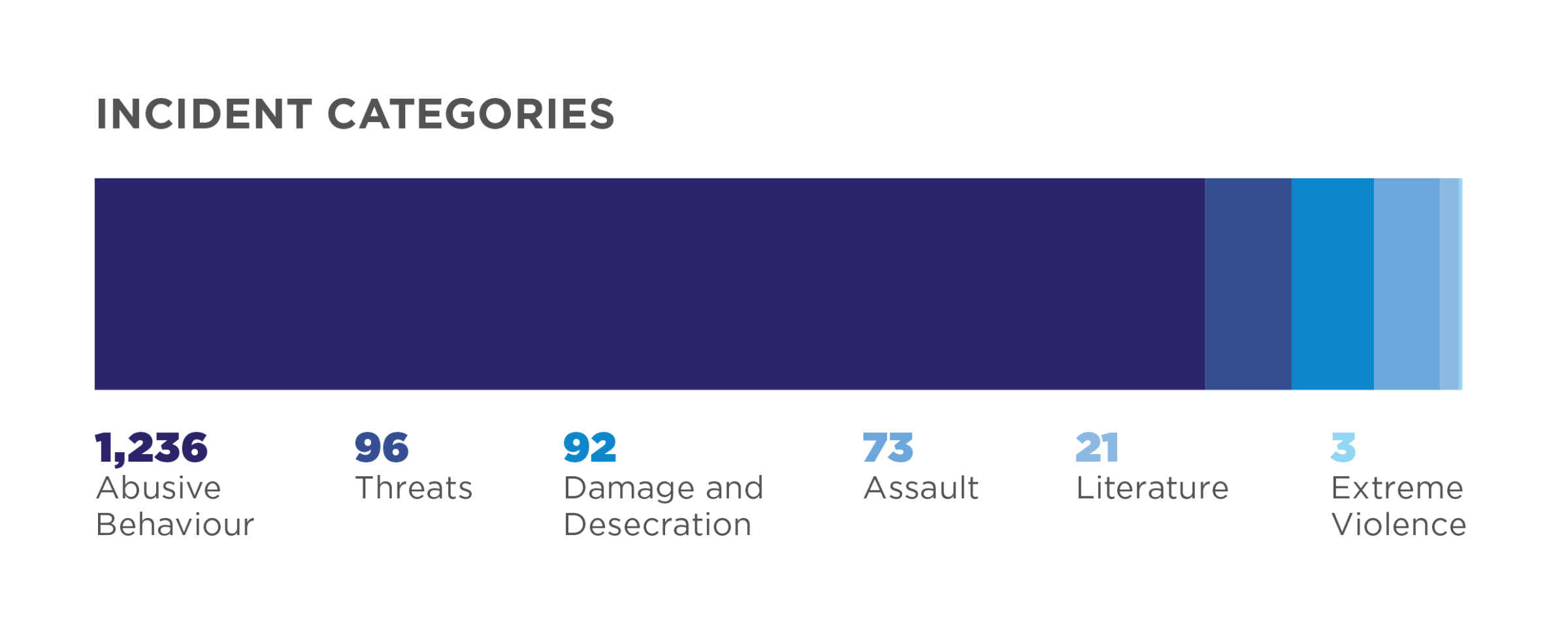
Of the 76 cases of Extreme Violence and Assault combined, 36 (47%) happened across just three UK boroughs: Barnet (18) in Greater London, and Bury (10) and Salford (8) in Greater Manchester. These areas are home to some of the largest and most identifiable Jewish communities in the country. Whereas just 27% of incidents in the other categories of anti-Jewish hate took place in these boroughs, physical attacks on Jewish life are more likely to target the areas where Jewish life is most visible and deeply established. The reality that Jewish life has profound roots in Britain may be perceived by offenders as an existential threat to a culture and territory they believe to be theirs. Perhaps perpetrators see these communities as so distinct from their own that they become easy to dehumanise, degrade and desecrate, or the visible Jewishness of many of the residents of these locations simply provides those who wish to physically harm Jews with a certainty of who and what they are attacking. Indeed, in at least 35 (46%) of these 76 violent incidents, the victim was identifiably Jewish, usually on account of their religious insignia, traditional clothing or Jewish school uniform.
Within the categories of Extreme Violence and Assault, an alarming proportion of children have been involved, both as victims and perpetrators of violent acts of antisemitism. Of the 68 reports of this kind wherein CST obtained the victim or victims’ age, 31 (46%) targeted minors, up from 37% in the first six months of 2024.10 Of the 53 assaults where the approximate age of the perpetrator or perpetrators was reported, 26 (49%) were described as being under the age of 18.
Across CST’s other categories of anti-Jewish hate, children were recorded as victims in 20% of incidents, and as offenders in 15%. Twenty- one (28%) of the 76 physical antisemitic attacks logged from January to June 2025 involved children assaulting children.
CASE STUDY
Assault, threats and abuse in Lancashire pub In April, a non-Jewish woman was in a Lancashire hotel pub with her parents when she found herself engaged in a confrontation with a group of males and females. They shouted, “You’re f***ing Jewish, I hate you, f**k you”. The victim replied that she is not Jewish and that they must be mistaking her for someone else. She decided to leave after further threats but the group followed her outside, with one of the females saying, “I’m coming for you”. The victim told them to back off but the female started attacking her, punching her and knocking her to the ground, continuing to punch her. One of the males started to kick her in the ribs. The whole attack took place over five minutes. The group then left and one of them shouted, “I hope your family will die”. The victim, who was physically and emotionally traumatised from this incident, spoke with CST, who offered her psychological support, and liaised with Lancashire Police as they built their investigation.
Damage & Desecration to Jewish Property
There were 92 instances of Damage & Desecration to Jewish property recorded by CST in the first half of 2025, a rise of 10% from the 84 incidents of this kind reported across the corresponding timeframe in 2024. This is the highest ever January-to-June figure recorded in this category. There were 24 incidents of this kind reported over the first six months of 2023, 30 between January and June 2022, and 59 in the first half of 2021. Thirty-three of these saw damage done to posters, ribbons and memorials in honour of the hostages captured by Hamas, 21 to the homes and vehicles of Jewish people, 16 to synagogues, eight to Jewish businesses and organisations, three to Jewish schools, one to a kosher food aisle at a supermarket, and one to a Jewish cemetery.
In 28 of the 92 instances of Damage & Desecration, the offender used graffiti, daubing, stickers or posters of an antisemitic nature to deface the Jewish target (19 of which were related to events in the Middle East), while 12 incidents involved the destruction or removal of a mezuzah (a Jewish prayer scroll affixed to a building’s entrance). Eggs, stones, bricks, bottles or other projectiles were thrown at Jewish property to cause damage on six occasions, and there were four cases wherein non-kosher food was deliberately left on Jewish property. One report featured the kicking of a Jewish home’s front door, one involved the offender spitting on a synagogue, and one resulted in the breaking of a Jewish school window. All included some element of anti-Jewish focus, language, targeting or imagery to be counted as antisemitic by CST.

CASE STUDY
Pig trotters placed in synagogue grounds in Kent In February, a man was caught on CCTV placing pig trotters through the fence of Chatham Memorial Synagogue in Kent. He admitted to the act in court, and was subsequently arrested again for breaching his bail conditions.11
Threats
CST recorded 96 direct antisemitic Threats or incitements to violence against Jewish people between January and June 2025, a decrease of 34% from the record 146 incidents of this sort reported in the first half of 2024. Fifty-five incidents were recorded for this category in the first half of 2023, 52 from January to June 2022, and 87 in the opening half of 2021.
CASE STUDY
Threatening email sent to London-based academic In February, a London-based Jewish academic received a threatening email titled, “Legitimate Target”. It read: “May I find you walking the streets of London, i’ll put a bullet through that Zionist face of yours” [sic]
Thirty of the 96 Threats were made in public, while eight were directed at Jewish businesses or organisations. Threats were directed at people in their homes in seven instances and at synagogues in a further seven, while congregants were twice threatened on their way home from services. Three were issued to schoolchildren on their way to or from their place of education, two to Jewish schools, and two within the context of non-Jewish schools. Two Threats occurred in the sphere of higher education, and public figures were also targeted in two incidents. Thirty-two of the incidents in this category were posted on online platforms, 14 were delivered via phone call or message, and there were six bomb threats reported.12
Abusive Behaviour
There were 1,236 antisemitic incidents recorded by CST in the category of Abusive Behaviour in the first half of 2025, comprising 81% of the overall total of 1,521 incidents and a 25% fall from the 1,649 instances of Abusive Behaviour recorded between January and June 2024. Alone, it surpasses the half-year overall figure across all categories in all other years aside from 2024 and 2021. There were 793 counts of Abusive Behaviour in the first half of 2023, 662 from January to June 2022, and 1,129 over the same timeframe in 2021. The umbrella of Abusive Behaviour spans multiple modus operandi, including the full range of written and verbal abuse (apart from direct threats), the latter of which can be in person or delivered through phone calls and voicemails. This category also includes antisemitic emails, text messages, direct messages, social media posts and comments, as well as targeted hate mail that is not produced and disseminated on a mass scale, and antisemitic graffiti on, or damage to, non-Jewish property.
In 220 of the Abusive Behaviour incidents reported, the victims were Jewish people in public, and visibly Jewish in at least 130 cases. Jewish businesses and organisations were the targets of 239 incidents in this category, while public figures – Jewish and not – were subjected to antisemitism on 77 occasions. Seventy-seven of these incidents related to the school sector, 26 to the university sector, and abuse was directed at synagogues or congregants travelling to or from their place of worship in 56 instances. Forty Abusive Behaviour cases involved the harassment of victims in their own homes, and 16 in the workplace.
Among the 1,236 incidents in this category, 379 involved spoken abuse and 590 written abuse, while 81 contained intimidating language without making a specific threat to a Jewish person, institution or community. There were 234 instances of antisemitic graffiti, daubing, posters or stickers on non- Jewish property: 170 of these depicted a swastika or included Nazi-era references, 74 were related to Israel and the war in the Middle East, and these two discourses were found concurrently in 48 cases of anti-Jewish vandalism. In 136 cases, antisemitic images, memes or cartoons were employed to cause upset, 35 of which portrayed Jewish people in a stereotypical or dehumanising way. One hundred and thirteen incidents in this category involved offensive shouts or gestures in public, 74 of which emanated from passing vehicles. CST logged 22 counts of hate mail that are not believed to have been mass-produced and distributed, and a further 21 abusive phone calls or voice messages.
Of the 1,236 reports classed as Abusive Behaviour, 534 occurred online, comprising 43% of the category’s total. These also constitute the majority of the 572 online cases of antisemitism logged across all categories. This half-year figure for online anti-Jewish hate, which is second only to January-to-June 2024 in CST’s records but forms a higher percentage of the incident total, represents the critical part that social media and instant messaging platforms play in the production, propagation and amplification of contemporary antisemitic prejudice. People who hate Jews can easily find others who share their racism, enable it, encourage it and affirm it. Their hatred now has a global reach, and it can reach its target at the touch of a button, anonymously if they so choose.
Every anti-Jewish post, comment, message, meme and video has the potential to inspire anti-Jewish action in the offline world. The proliferation of antisemitism on these virtual fora dilutes the taboo against it, with consequences both online and in person. The relentless flow of social media-based information, interaction, debate, partisanship and anger regarding Israel and the war in the Middle East cannot be disaggregated from the continued high volume of anti- Jewish hate incidents recorded throughout the country.
CASE STUDY
Abuse of school pupil in Sussex In February, a German-Israeli schoolboy was in the UK to study at an international school for three months, as part of a scheme arranged by his school in Germany. He had to curtail his stay due to the antisemitism he faced from other students. Comments included, “I hate Jews, there shouldn’t be any Jews in the world”, and “Kill Jews and Muslims – there should only be Christians”. In an art lesson, the pupils were instructed to draw a picture of something that represents their country. A German student drew a picture of Hitler saluting and swastikas. This was shown to the art teacher who laughed. Several swastikas were also drawn around the school and, on the victim’s final day, when the pupils were instructed to draw a book cover, a German student drew Mein Kampf.
Literature
There were 21 incidents reported to CST in the category of mass-produced antisemitic Literature in the first half of 2025, an increase of 50% from 14 such incidents reported in the first six months of 2024, and the second-highest figure ever logged for this category in the January-to-June period. CST recorded seven instances of Literature distribution in the first half of 2023, four between January and June 2022, and five in the corresponding period of 2021.
In eight of the antisemitic incidents recorded in this category over the first six months of 2025, public walls were reported to have been plastered with mass-produced antisemitic posters, four of which were produced and distributed by far-right group the Goyim Defence League (GDL). On seven occasions, the offender spammed synagogues, rabbis and Jewish organisations with antisemitic emails. In two cases, anti-Israel hate mail was posted to synagogues. In one instance, Jewish public figures and institutions were spammed with an identical abusive comment on X; in another, several university chaplains received an email filled with antisemitic and anti-Muslim conspiracy theories and stereotypes; there was one example of a far-right newspaper posted to Jewish properties in a Greater Manchester neighbourhood; and one incident involving a leaflet equating Zionists with Nazis at a demonstration for Palestine.
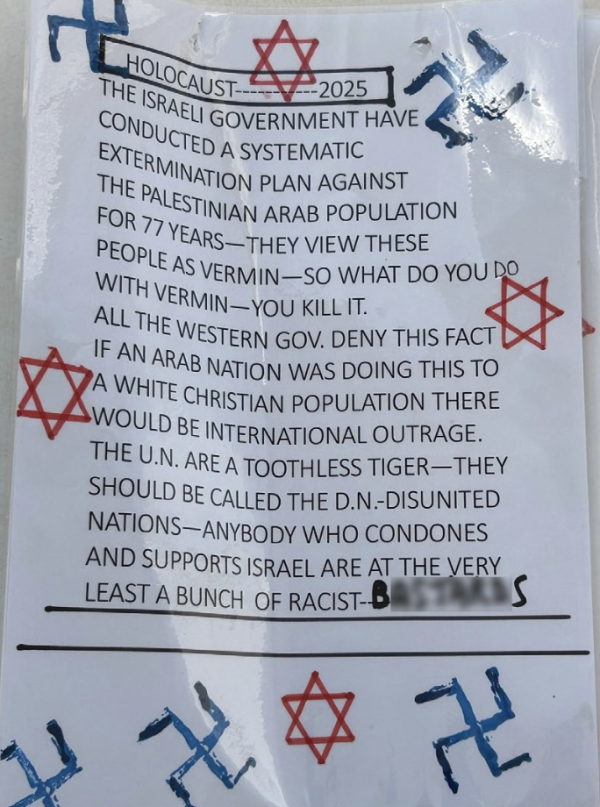
CASE STUDY
Posters in London comparing Israel to Nazi Germany In May, mass-produced posters were reported in London comparing the war in Gaza with the Holocaust. Swastikas were printed across it alongside lone Stars of David – not part of the Israeli flag.

Incident Victims
The victims of antisemitic incidents come from the whole spectrum of the Jewish community: from strictly orthodox to liberal, reform and secular Jews; from the largest Jewish communities to small, isolated communities across the UK; from Jewish schoolchildren to Members of Parliament. Occasionally, antisemitism will also be directed at people who do not identify as Jewish.
There were 315 antisemitic incidents reported to CST in the first six months of 2025 in which the victims were ordinary Jewish individuals in public. In at least 181 incidents, they were visibly Jewish on account of their traditional clothing, Jewish school uniforms, jewellery, insignia or other items bearing religious symbols. From January to June 2024, this was true of 596 and 275 reports respectively. There was an element of spoken abuse in 503 of the 1,521 incidents recorded by CST in the first half of 2025, of which 97 incorporated threatening language. Anti-Jewish hate was conveyed through shouts or gestures by random strangers in public in 131 instances, of which 86 were perpetrated by the occupant of a vehicle. These modus operandi are broadly indicative of the most common single type of offline incident reported to CST since the organisation began compiling statistics: the random, unprovoked, verbal or signalled harassment of individuals who are presumed for whatever reason to be Jewish, as they go about their daily lives in public spaces.

The ongoing war in the Middle East has continued to inform the language employed in these incidents. Of the 503 cases of verbal abuse recorded in the first six months of 2025, 216 explicitly referenced Israel and events in the region alongside anti-Jewish rhetoric or targeting. In at least 81 of these instances, the phrase “Free Palestine” was used, aimed at unsuspecting Jewish people in public on 58 occasions. This phrase is not inherently antisemitic and, in isolation, would not be classed as an antisemitic incident by CST. However, in these examples it was deployed to harass, intimidate and alarm Jewish people and institutions simply because they are Jewish, or were perceived to be in the moment. Under such circumstances, “Free Palestine” becomes associated with Jewish identity, whether imagined or factual, and this combination transforms the slogan into one imbued with antisemitic underpinnings.
In the first half of 2025, there were 24 antisemitic incidents recorded at Jewish schools, compared to 30 between January and June 2024. A further 41 incidents involved Jewish schoolchildren away from school premises, often on their commute to or from home, compared to 51 incidents of this type reported across the same period in 2024. CST recorded 42 incidents involving schoolchildren or staff at non-Jewish schools, falling from the 84 such cases logged in the first six months of 2024. This comprises a total of 107 incidents affecting people and buildings in the school sector, falling by 35% from the 165 such incidents reported in the first half of 2024. In the first half of 2023, a period when anti-Jewish hate in the UK was not impacted by war in the Middle East, CST recorded 74 school-related antisemitic incidents.
Of the 107 antisemitic incidents affecting schools, pupils and staff, 20 came under the category of Assault (14 targeting schoolchildren on their way to or from school, five in which children were attacked by classmates at non-Jewish schools, and one wherein Jewish boys were accosted as they exited their faith school); three incidents were classified as Damage & Desecration to Jewish property; seven involved direct Threats (three to schoolchildren on their commute, two to Jewish schools, and two to Jewish pupils at non-faith schools); and there were 77 instances of Abusive Behaviour. The fact that physical attacks account for 19% of incidents in the school sector, but just 4% of reports from other environments, correlates with the worryingly high proportion of children involved as victims and perpetrators of antisemitic violence, covered in the Incident Categories chapter of this report.
In the sphere of higher education, CST logged 35 antisemitic incidents throughout the first half of 2025. These are incidents that affect Jewish students, academics, student unions or other student bodies, or were perpetrated by people involved in the university sector. This is a sizeable fall of 64% from the 98 incidents of this type reported between January and June 2024. Of these 35 university-related incidents, two were classified as Extreme Violence, two as Assault, one as Damage & Desecration to Jewish property, two as Threats, 26 as Abusive Behaviour, and two as mass-produced antisemitic Literature. Sixteen of them took place on campus or university property (compared to 46 in the first six months of the previous year), while 19 occurred away from campus, of which 13 were online (compared to 52 and 46 incidents respectively over the same timeframe in 2024).
Although substantially lower than the half-year total for incidents of this kind reported across the first half of 2024, the 35 instances of anti-Jewish hate recorded in the context of higher education from January to June 2025 is more than double the 17 such cases logged in the corresponding period in 2023. This is, in part, because of antisemitic reactions to the ongoing war in the Middle East. Twenty-one (60%) of these 35 incidents involved Israel-related discourse alongside explicit anti-Jewish hate or motivation, while this was the case in 51% of all the incidents that were not linked to university life. This disparity cannot be attributed to a single reason, but several aspects of university life may be pertinent in assessing why conflict in the Middle East is represented disproportionately often in the language of campus-based antisemitism. There is a longstanding tradition of anti- Israel student activism which can contribute towards an environment in which some individuals may feel encouraged or emboldened to respond to the current war in the region with antisemitism. This may also be shaped by a desire to belong to a cause. The frequent equation of Israel’s alleged actions to the Holocaust, apartheid, colonialism or other historic barometers of evil frames the topic of this conflict as a binary moral choice. The pressure of this choice, for all the reasons hypothesised above, may be felt more acutely in student circles.
There were 74 antisemitic incidents recorded from January to June 2025 that targeted synagogues (including buildings, staff and congregants while at the location), a slight decrease from the 77 incidents of this kind in the first half of 2024. An additional 13 incidents saw congregants or staff targeted on their way to or from prayer services, compared to 38 such incidents reported to CST in the first six months of 2024. This represents a 24% fall in instances of anti- Jewish hate impacting synagogues and the people travelling to, from, or already inside them, from 115 in the opening half of 2024 to 87 in the first six months of 2025, the second-highest half-year figure reported for incidents of this kind. One of these incidents was classed as Assault, while 16 involved the Damage & Desecration of synagogue property. There were nine cases of direct Threats made (seven to Jewish places of worship and two to congregants in public), 56 incidents classified as Abusive Behaviour, and five as Literature. Forty-one (47%) of the 87 instances of antisemitism logged in the synagogue sector contained Israel-related rhetoric. Synagogues are places of prayer and communal activity, and identifiable signifiers of Jewish presence in any neighbourhood. As such, an attack on a synagogue is not a political statement against Israel but attack on Jewish life in the UK. From life, to death: one incident reported to CST in the first six months of the year targeted a Jewish cemetery, whereas none did in the same timeframe in 2024.
Seventeen antisemitic incidents were related to the workplace, down from 23 incidents of this nature reported in the first half of 2024. There were 257 incidents that targeted Jewish organisations and businesses – including one youth movement – falling by 21% from the 325 such incidents recorded from January to June 2024. This is the second-highest six-monthly total for incidents of this type. CST and other communal organisations have continued to attract online hate from people who blame Jewish people and institutions for circumstances in the Middle East, particularly when they have publicly condemned antisemitism and the environment that the high levels of anti- Jewish hate have created for Jewish people in the UK since 7 October 2023. In 204 (79%) of these 257 reports, the offender used discourse referencing Israel and the war in the region. In 64 (25%), they drew on the conspiracy theory that Jews wield a disproportionate power over world affairs. The worst day for recorded antisemitism in the first half of the year was 29 June, when 26 anti-Jewish hate incidents were logged, the day after punk-rap group Bob Vylan chanted “Death to the IDF” at Glastonbury Festival. Of these, 12 were antisemitic reactions to statements issued by Jewish organisations in response to events at Glastonbury.13 14
Two hundred and eighteen (85%) of the 257 incidents in which Jewish organisations and businesses were victims took place online, while this was the case for 74 (91%) of the 81 reports of anti-Jewish hate wherein people of public prominence were targeted. These 81 cases, of which 70 (86%) referenced the Middle East and 31 (38%) spoke of global Jewish control, constitute an increase of 7% from the 76 incidents targeting high profile individuals from January to June 2024. These statistics demonstrate how public figures – Jewish and non-Jewish – and Jewish institutions are deemed accountable for Israel’s alleged actions and the situation in the Middle East. In some cases, offenders who make these accusations of culpability rehash the antisemitic myth of Jewish collusion and conspiracy, or paint the image of Israel as puppet masters, buying the complicity of various agents within British society.
CST recorded 74 incidents that took place at people’s residential property or affected their parked vehicles in the first half of 2025. This is a fall of 25% from the 99 incidents of this type that occurred in the first six months of 2024. Twenty-eight of these were perpetrated by a neighbour or somebody known to the victim, forming part of the 112 instances of anti-Jewish hate wherein the victim and offender had some kind of relationship to one another prior to the incident. These “interpersonal” cases comprise 7% of all the antisemitic incidents reported to CST from January to June 2025, a decrease from 155 recorded over the corresponding period last year.
There were 12 antisemitic incidents reported to CST in the first half of 2025 that were in some way related to professional football, just over the 11 such incidents recorded between January and June 2024. Of these, three involved racist abuse inside a stadium, two were reports of anti-Jewish hate in a non-stadium environment, and seven were online incidents. A further five incidents were reported in the context of amateur football, falling from 12 across the same timeframe in 2024. One incident was recorded in an amateur rugby setting.
CST received a description of the victim or victims’ gender in 694 of the 1,521 antisemitic incidents recorded in the first half of 2025. Of these, 391 (56%) were male; 210 (30%) were female; in 92 incidents (13%), the victims were mixed groups of males and females; in one incident, the victim identified as non-binary.
The victim or victims’ age was ascertained in 689 of the 1,521 antisemitic incidents reported to CST from January to June 2025. Of these, 535 (78%) involved adult victims, of which 17 were over the age of 65; 110 (16%) involved victims who were minors; in 44 instances (6%), mixed groups of adults and minors were targeted. Alarmingly, of the 154 incidents in which there were victims under the age of 18, 31 (24%) were classified as Assault, whereas of the 579 incidents with adult victims, 39 (6%) were physical attacks.
Incident Offenders
It is not always easy to ascertain the ethnicity, gender or age of antisemitic incident offenders. Many face-to-face incidents involve fleeting, nonverbal, public encounters in which the offenders may not be fully visible or leave the scene quickly. Victim and witness testimonies may be vague and disjointed, which is understandable given the nature of the ordeal that they have experienced. Some incidents do not involve face-to-face contact, and it is therefore not always possible to obtain a physical description of the perpetrator. Furthermore, those who commit antisemitic offences online may choose to completely anonymise themselves, which makes it almost impossible to garner any information about the person behind the abuse. On the other hand, if social media profiles are not anonymised, they can provide some personal details of offenders, such as a name, photograph or approximate location.
While it is possible to collect data regarding the ethnic appearance of incident offenders, this data is not direct evidence of the offenders’ religious affiliations. The content of an antisemitic letter may reveal the motivation of the offender, but it would be a mistake to assume the ethnicity or religion of a hate mail sender solely on the basis of the discourse they employ.
CST obtained a description of the ethnic appearance of the offender or offenders in 588 of the 1,521 antisemitic incidents reported from January to June 2025. Of these, 278 (47%) were described as white – North European; 14 (2%) as white – South European; 59 (10%) as black; 81 (14%) as South Asian; four (1%) as Southeast Asian; finally, 152 (26%) were described as Arab or North African. These percentages are broadly similar to those reported across 2024, but diverge from the typical breakdown of perpetrator ethnicities recorded when Israel is not at war. For comparison, in the first six months of 2023, 47% of offenders were described as white – North European; 3% as white – South European; 17% as black; 13% as South Asian; less than 1% as Southeast Asian; and 20% as Arab or North African. This shift towards a higher proportion of offenders perceived as having an Arab or North African appearance matches the pattern observed at other times when conflict in the Middle East has intensified. It is important to bear in mind that these details rely on the subjective and often momentary judgement of victims and witnesses, made in what can be brief, disorienting and distressing encounters.
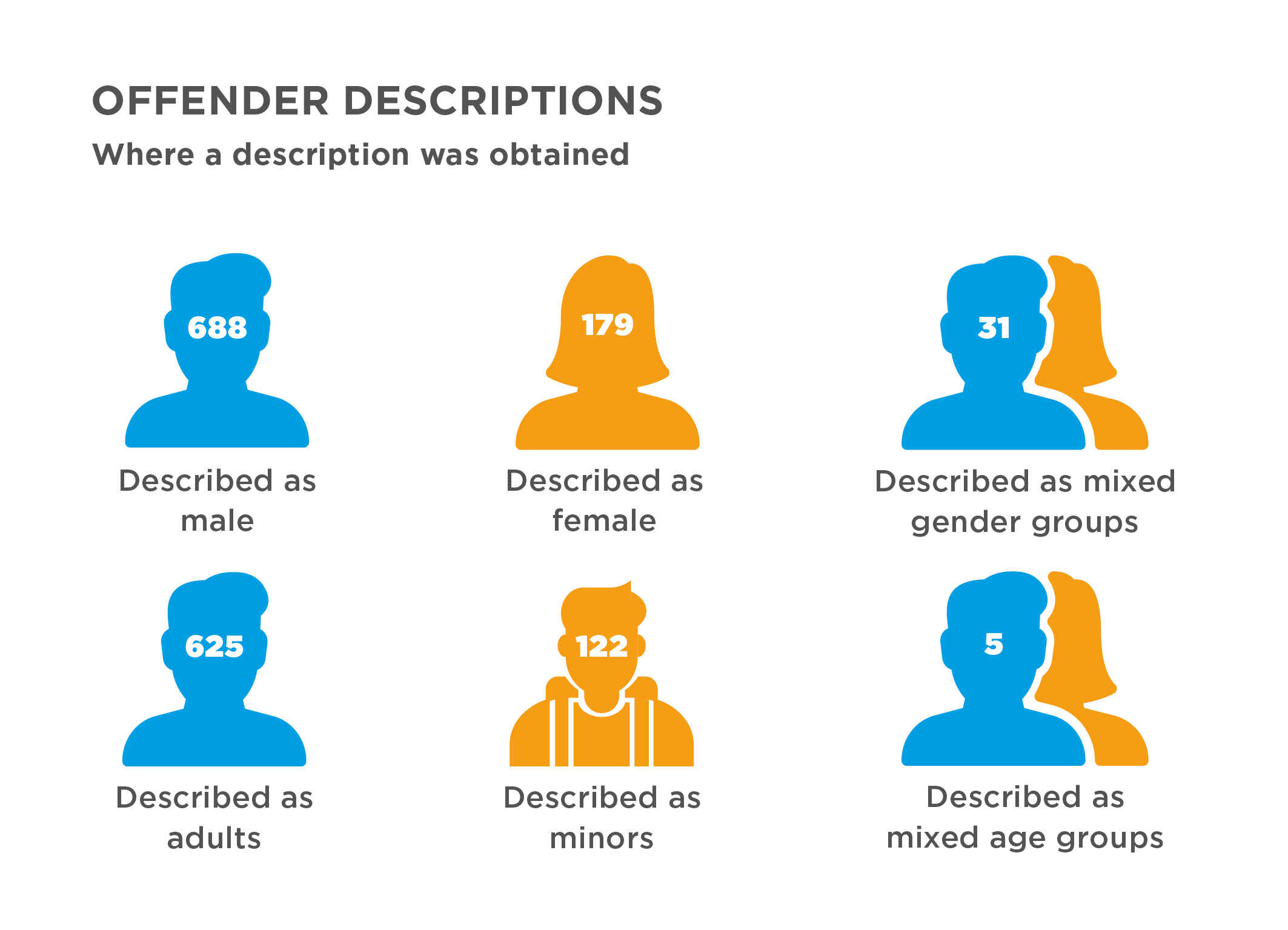
A description of the gender of the offender or offenders was obtained by CST in 898 of the 1,521 antisemitic incidents recorded in the first half of 2025. Of these, the offender was described as male in 688 incidents (77% of the incidents where the offender’s gender was obtained); female in 179 incidents (20%); and mixed groups of males and females in 31 incidents (3%). These percentages are consistent with those reported in 2024 but, like the recorded offender ethnicities, differ from those logged between January and June 2023, when 84% of perpetrators were described as male and 14% as female. This change may have roots in the context of the Middle East war. Of the 179 incidents to feature exclusively female perpetrators, 75% contained language pertaining to Israel, Gaza and the conflict, while 69% were explicitly anti-Zionist. For the 688 incidents with exclusively male offenders, these figures were 52% and 46% respectively. There is no obvious reason why women might be more likely than men to engage in anti-Israel or anti-Zionist rhetoric alongside antisemitism inthe incidents recorded by CST.
In 752 of the 1,521 reports of anti-Jewish hate between January and June 2025, CST was provided with a description of the approximate age of the offender or offenders. Of these, 625 (83%) involved adult offenders, of which 16 involved adults described as over the age of 65; in 122 cases (16%) the perpetrators were minors; and there were five instances (1%) in which offenders were a mixture of adults and minors. These percentages are consistent with those recorded since 2021, when the intensification in the conflict between Israel and Hamas in May of that year precipitated a high volume of anti-Jewish activity in school environments and antisemitism perpetrated by children increased as a proportion of the whole. This proportion has remained elevated since, and throughout the current war.
Discourse, Motivation & Ideology
CST attempts to assess the number and patterns of antisemitic incidents that take place in the UK each year in which there is evidence of political, religious, or ideological discourse or motivation. CST also counts the instances where conspiracy-fuelled sentiments are present. Stereotypical tropes about Jewish people’s power, influence, and money – and exaggerating or inventing the tragedies of the Holocaust – can be especially prevalent in online expressions of antisemitism. It is common for two or more of these discourses to exist within the same incident, even if they would seem ideologically incompatible. Such apparent contradictions perfectly capture the multifaceted nature of contemporary anti- Jewish hate. In total, 1,158 (76%) of the 1,521 antisemitic incidents recorded by CST in the first half of 2025 presented evidence of one or more political or ideological discourses or motivations. From January to June 2024, they were present in 1,437 (71%) of 2,019 incidents and, over the same timeframe in 2023, they were present in 516 (53%) of 965 incidents. This increase in political and ideological language and motivations the longer the war in the Middle East has continued is another indicator of its impact on the content of antisemitism in the UK.
Historic, simplistic prejudices have been manipulated and deployed by such a vast array of social, religious, cultural and political forces over such a long period of time, that a complex and layered landscape of antisemitic language, imagery and references now exists. Partly as a consequence of this, the use of a certain rhetoric does not necessarily evidence a specific motivation or allegiance: for example, a person who shouts “Heil Hitler” at a Jewish passer-by might align themselves with far-right extremist ideology, or they might simply know that this phrase will cause upset and offence to Jewish people. Similarly, someone who shouts “Free Palestine” at people walking to synagogue may be a staunch campaigner for Palestinian liberation, or perhaps they just consider it another weapon in their rhetorical arsenal to deploy against Jews.
Israel-related antisemitism

In the first half of 2025, the discourse most often reported in antisemitic incidents alluded or was in some way connected to Israel, Gaza, the Hamas terror attack on 7 October 2023 or the ensuing Middle East war (alongside anti-Jewish language or targeting). This narrative was evident in 779 (51%) of the 1,521 cases of anti-Jewish hate recorded by CST between January and June 2025. It is a decrease of 25% from the 1,043 incidents involving this rhetoric reported in the first half of 2024 – 52% of the six-monthly total – though significantly higher in number and proportion than in the corresponding timeframe of 2023, when 151 incidents were related to this topic, making up 16% of the six-monthly total. These statistics demonstrate the difference in the language of anti-Jewish hate between periods of war in the Middle East, and those without a significant trigger event in the region. This discrepancy is also apparent in the 703 antisemitic incidents recorded in the first half of the year that showed explicitly anti-Zionist motivation alongside anti-Jewish hate speech or targeting: 46% of all reports. From January to June 2024, this motivation was evident in 42% of incidents, and just 10% of incidents in the corresponding timeframe in 2023. Variations on the terms “Zionism” or “Zionist” were used on 210 occasions, often as bywords for “Jewishness” and “Jew” or alongside antisemitic ideas or targeting, just surpassing 209 such incidents in the first half of 2024, and far outstripping the 47 cases of this type logged in the first six months of 2023. In at least 121 instances, the phrase “Free Palestine” was employed, either in speech or writing. CST does not regard this in itself to be an antisemitic phrase, but in each of these cases, it was targeted at Jewish people or institutions – who had not solicited discussion about the Middle East – simply for being Jewish or perceived as Jewish by the offender, or comprised part of a larger tirade that did include blatantly anti-Jewish hate.
Holocaust-related antisemitism

In 477 incidents – 31% of the 1,521 instances of antisemitism reported to CST in the first half of 2025 – the offender or offenders made reference to Hitler, the Nazis, the Holocaust, and/or punctuated their abuse with a Nazi salute, the depiction of a swastika, or other related imagery. This is a decrease of 7% from the 513 incidents using this rhetoric in the first half of 2024, which comprised 25% of the January-to-June total. Nazi-related language and imagery is typically the dominant single narrative type during periods without an Israel-related trigger event, and remains a core reference point for antisemites when there is one. In 26 of the 477 incidents of this nature in the first half of 2025, the perpetrator denied either the scale of the Holocaust, the facts of the Holocaust, or its having happened at all (down from the 37 such cases recorded in the first six months of 2024). One hundred and seven reports involved celebration of the Holocaust, the glorification of its architects and/or their ideas, or the expressed desire for the mass industrialised extermination of Jewish people to repeat, rising by 75% from the 61 incidents of this type logged between January and June 2024. Of these 107 incidents, 31 were also Israel-related, which claimed that Israel has shown Hitler to be right about the Jews, or lamented his failure to fully wipe out the Jewish population and thereby prevent Israel’s existence and response to Hamas’ terror attack. On six occasions, the offender simultaneously denied and celebrated the Holocaust, a paradox that sums up the confusion and illogic that can exist in the minds of antisemites. In 177 of these 477 instances of Nazi-related hate, abuse was graffitied, daubed, scratched, stuck or printed on public or private property, usually incorporating the illustration of a swastika. There were 104 cases wherein far- right allegiance or political motivation were present, 69 of which were accompanied by Nazi-era references, increasing from 64 and 46 such incidents respectively in the first half of 2024. On 172 occasions, the offender made a direct equivalence between Israel and Nazi Germany, falling from 192 such parallels drawn in the opening six months of last year. Incidents involving this comparison are counted among the totals for both Israel- and Holocaust-related antisemitism, bridging the two most popular discourses deployed by purveyors of anti-Jewish hate in the January-to-June window.
Religiously motivated antisemitism
CST recorded 53 incidents containing rhetoric relating to Islam, Muslims and Islamist groups alongside antisemitism in the first six months of 2025, decreasing from 73 reported in the first half of 2024. There was also a fall in those involving Islamist extremist ideology, with 19 reported compared to 37 between January and June 2024. From January to June 2023, CST recorded nine incidents using Islam-related discourse and four displaying Islamist extremist ideology. These discourses and ideologies are witnessed far more frequently in the content of anti-Jewish hate when Israel is at war. Of the 19 incidents involving Islamist extremism, 13 were in reference to the conflict, showed support for Hamas and the 7 October terror attack, or expressed hope that Hamas would be successful in its mission to wipe out Israel. An additional 37 instances of anti-Jewish hate featured another religious ideology, rising from 18 in the first six months of 2023. Twenty-two of these were Israel-related, and most involved arguments that Jewish people, Zionism and or Israel do not align with Christian values.
Conspiracy theories

Antisemitic conspiracy theories were evident in 222 (15%) of the 1,521 incidents recorded in the first six months of 2025, marking a fall from 243 between January and June 2024. Of these, 165 alleged Jewish influence, nationally or globally, over politics, media, finance, migration and other walks of life (equal to 165 in the first half of 2024); 55 promoted falsehoods regarding religious rituals and practices, such as the ritual murder or ‘Blood Libel’ charge (down from 63 from January to June 2024); and ten involved myths regarding the origins of Jewishness in attempts to undermine the legitimacy of any notion of a modern Jewish identity or nationhood (up from seven in the corresponding timeframe in 2024).
Antisemitism targeting customs & text
There were 40 incidents in which specific aspects of Judaism were attacked or purposely mischaracterised in an antisemitic way, down from 54 such incidents reported in the first six months of 2024. Among these, 28 manipulated ideas taken from religious scripture (more than the 27 recorded in the first half of 2024); 13 singled out religious literature and holy books (whereas 18 did from January to June 2024); and nine focused on religious traditions and practices (equal to the nine such incidents in the first six months of 2024). In 152 cases, the perpetrator resorted to anti-Jewish stereotypes, caricatures or dehumanising language and imagery, lower than the 162 incidents of this type over the same period in 2024. There were seven examples of antisemitic abuse towards specific ethnic groups that exist within the Jewish community, rising from one recorded in the first half of 2024.
Politically motivated antisemitism
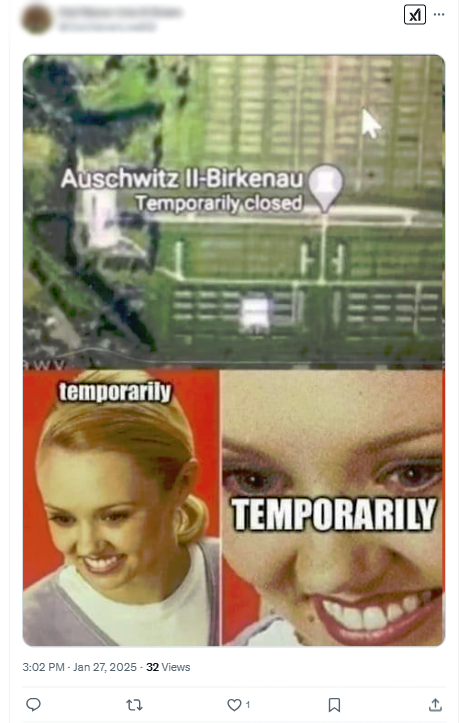
Antisemitic incidents are classified as connected to specific political parties based on the offender’s stated affiliation or support; because the abuse was targeted at, or expressed by, party members, activists or representatives; or because an incident appeared to be motivated by news stories related to that party. It is often not possible to ascertain whether the offenders are themselves party members or not; in some cases, they have been expelled from their former party but continue to express antisemitism in relation to it. These caveats mean that these totals are not indicators of the relative amounts of antisemitism within, or tolerated by, each political party. With that in mind, 25 antisemitic incidents recorded by CST in the first half of 2025 were connected to specific political parties or their supporters, or to issues in mainstream politics. Eleven were linked to the Labour Party, four to the Conservative Party, two to Reform UK, two to the Socialist Workers Party, one to the National Housing Party UK, one to the British Democratic Party, one to the Alba Party, and one to an independent Member of Parliament. This is a decrease from the 35 incidents associated with mainstream politics reported between January and June 2024, during which a General Election was called, when 20 were linked to the Labour Party, five to the Workers Party of Britain, two to the Conservative Party, one to the Green Party, one to the Liberal Democrats, one to the Socialist Workers Party, one to the National Housing Party UK, and four to independent parliamentary candidates and councillors. Thirteen of the 25 political party-related cases of anti-Jewish hate contained rhetoric pertaining to the Middle East, of which six alleged that British politicians are under Israel or “Zionist” control.
Since CST began recording antisemitic incidents in 1984, the chameleonic nature of anti-Jewish hate has consistently proven itself in the way that its language adapts to whatever the current landscape of social, political and cultural context, even if the central ideas are drawn from classical antisemitic tropes. This has been evident in the increases of reported antisemitism whenever Israel has been at war, as well as in the content of these cases: the fact that the majority of incidents logged in the first half of 2025 – and since 7 October 2023 – have involved Israel-related discourse is testament to this trend.
But even within periods where anti-Jewish prejudice is impacted by events in the Middle East, fluctuations in its volume and rhetoric are observed. In the first six months of the year, the lowest monthly total for antisemitic incidents was recorded in February with 200 reports made to CST. This was also the month with the lowest total for antisemitic incidents containing Israel-related discourse – 83 incidents – and the month where these incidents formed the lowest proportion of the monthly total – 42%. The Israel-Hamas ceasefire agreement came into effect on 19 January and ended on 18 March, meaning February was the sole month for which the ceasefire lasted its entirety.15 Contrast this to June, the worst month for anti-Jewish hate recorded between January and June 2025 with 326 incidents. This was also the month with the highest total for antisemitic incidents containing Israel-related narratives – 200 incidents – and the month where these incidents formed the highest proportion of the monthly total – 61%. It was in June that Israel and Iran were engaged in a 12-day conflict.16 At the end of the month, CST marked its highest daily total across the first six months of the year due to a spike in anti-Jewish reactions to events at Glastonbury Festival – where punk-rap group Bob Vylan led chants of “Death to the IDF” – and to the subsequent responses issued by Jewish communal organisations. In fact, incident levels had already started to increase in May following the bombing of the Gaza European Hospital in 13 May. Prior to this airstrike, May’s average daily total for anti-Jewish hate incidents was seven, with an average of three incidents per day referencing Israel and the Middle East. These averages respectively rose to ten and five incidents per day for the rest of the month. This is a microcosm of contemporary antisemitism, which seems almost reflexive to Israel’s prominence in public discourse, whether because of the resumption or escalation of war in the Middle East, or because a celebrity has decided to voice their hatred of Israel on stage at the country’s most famous music festival.
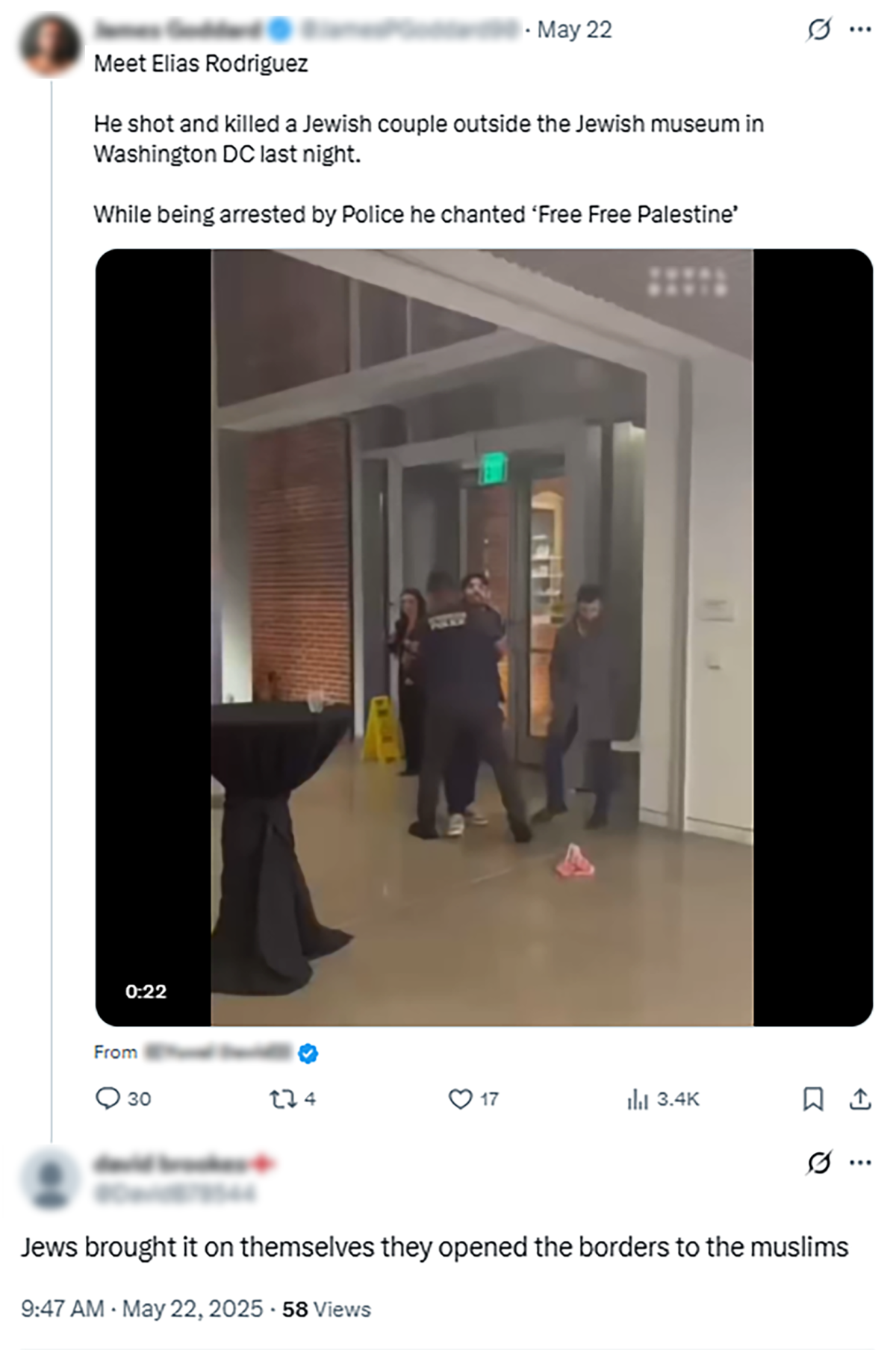
Much of the anti-Israel sentiment that slips into the antisemitism reported to CST stems from the pattern of anti-Zionist thought among the radical left. However, 20 of the 779 incidents that used Israel-related discourse also showed evidence of far-right ideology. Ten of these glorified the Holocaust (out of a total of 31 incidents that referenced Israel and the Middle East and also glorified the Holocaust). The other ten painted “Zionists” as being lesser humans than white Christian Europeans, or held them responsible for engineering war in the Middle East to prompt mass immigration into Europe, or blamed them for the JFK assassination and 9/11 terror attacks on the USA, or claimed that the murder of Israeli Embassy employees in Washington in May happened because, “Jews brought it on themselves they opened the borders to the muslims” [sic]. These incidents are also emblematic of modern-day anti- Jewish hate, wherein traditional tenets of extreme left-wing and extreme right-wing antisemitism overlap in their centralising demonisation of Israel, Zionism and, to varying degrees of unambiguity, Jews.
The discourses, motivations and ideologies explored in this chapter illustrate the variety of strands of anti-Jewish hate, the opportunism of its perpetrators, and the complexity of tackling it. This is a prejudice that draws on an archive of myths, stereotypes and fantasies. Its perpetrators, who occupy positions across the sociopolitical spectrum, use them alongside the warping of historic Jewish trauma as a means to beat their targets. Of the 1,158 antisemitic incidents recorded by CST from January to June 2025 that featured at least one of the political, religious and racist discourses, conspiracy theories, tropes and ideologies explored earlier in this chapter, 82 (7%) combined two or more of them.
Geographical Locations
Of the 1,521 antisemitic incidents recorded by CST in the opening six months of 2025, 968 occurred across Greater London and Greater Manchester, the two UK cities where the biggest Jewish populations reside.
In the former, 774 incidents were reported, marking a drop of 26% from the 1,051 incidents recorded in Greater London from January to June 2024. Greater Manchester’s half-year total of 194 incidents constitutes a fall of 28% from the 270 that took place in the same area over the equivalent timeframe in 2024.
CST recorded at least one incident in each London borough bar Bromley, Croydon, Hounslow and Merton. Of the 774 incidents reported across Greater London in the first six months of 2025, 325 – 42% of London’s total – occurred in Barnet, the local authority that is home to the biggest Jewish community in the UK. There were 95 instances of antisemitism reported to have taken place in Westminster, 79 in Camden, 34 in Hackney, and 22 in both Haringey and Harrow. Jewish people live, work, pray and attend school in each of these boroughs, but Westminster continues to be placed higher within CST’s Greater London statistics than it typically did prior to October 2023: it would regularly rank among the top five London boroughs for antisemitic incidents due to its high footfall and political importance, but rarely second behind Barnet. One reason for this recent shift is the fact that Westminster has hosted many of London’s anti-Israel demonstrations, vigils for the hostages captured by Hamas, and memorial services for the victims of 7 October. Although the majority of the people who participate in these events do so in a peaceful and respectful manner, there were at least 33 reports of anti-Jewish hate speech, placards or leaflets that took place at, or in transit to or from, Westminster’s anti-Israel protests or hostage vigils. Westminster is also home to several prominent Jewish community organisations and synagogues. Twenty-one cases of antisemitism in the borough targeted the former, and 13 targeted synagogues in Westminster.
Within Greater London’s data, 62 incidents were reported to have taken place on the London transport network, 44 of which occurred on property that falls under the remit of the British Transport Police. A further 60 were online incidents where either the victim or offender is understood to be based in London, but a more specific location could not be established. The figure for Greater London would be even higher, were it not for a technical problem from March 2024 onwards that has disrupted the flow of reports received from the Metropolitan Police as part of CST’s information exchange with police forces. CST’s collaboration with the Metropolitan Police – and all police
Incident Locations
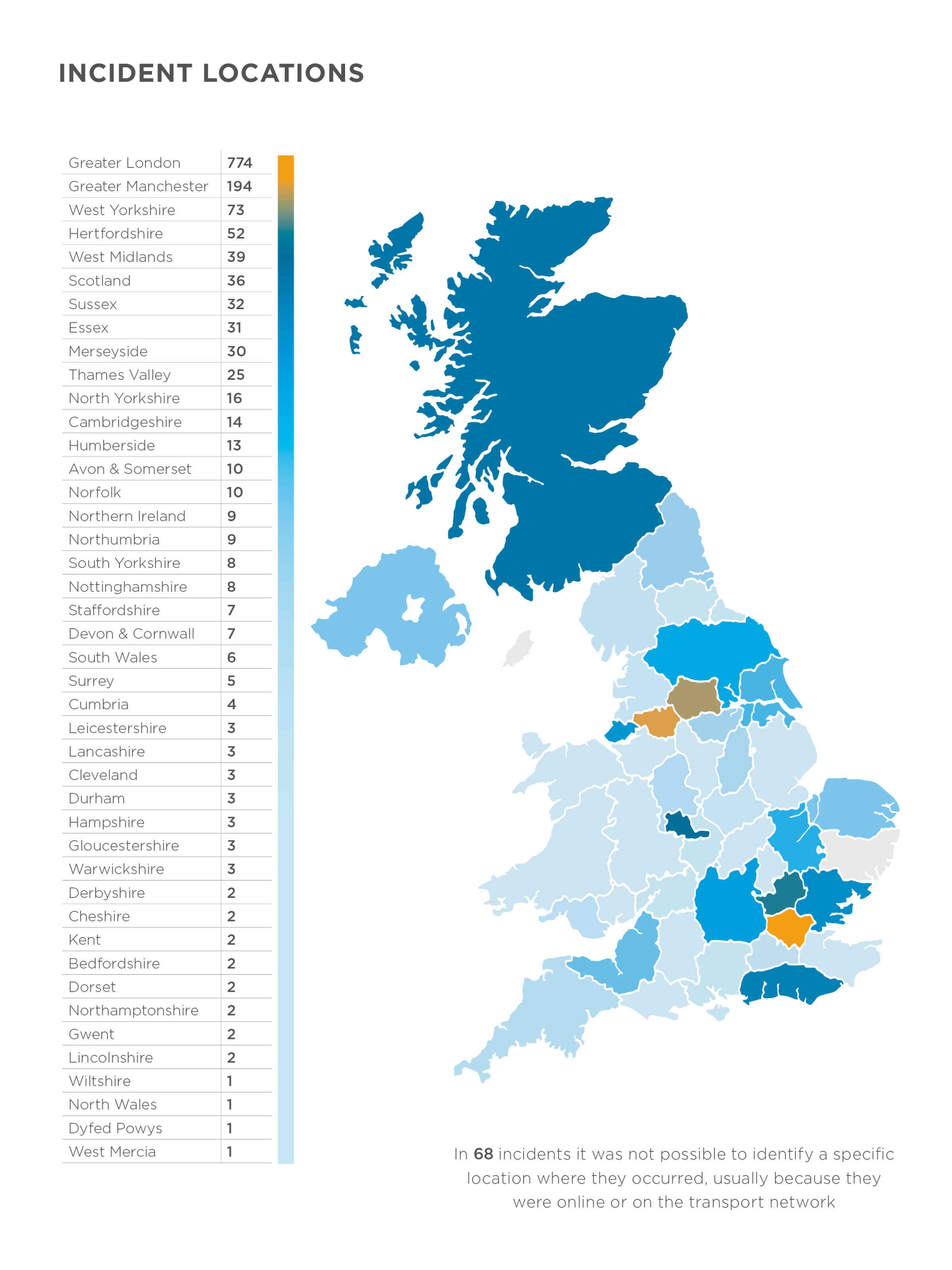
In 68 incidents it was not possible to identify a specific location where they occurred, usually because they were online or on the transport network services across the country – is of immense value and remains a core component of CST’s daily work.
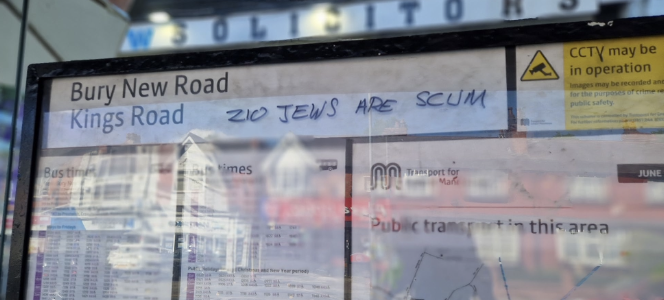
Of Greater Manchester’s 194 antisemitic incidents recorded between January and June 2025, 59 happened in the City of Manchester, 50 in Bury, 41 in Salford, nine in Stockport and seven in Oldham. Included in Greater Manchester’s incident data are eight incidents that occurred on the local transport network, and six online incidents where the offender is known to be based in the region, but it was not possible to pinpoint a specific location.
The combined proportional contribution of Greater London and Greater Manchester to the overall six-monthly antisemitic incident tally fell slightly from 65% in the first half of 2024 to 64% from January to June 2025. It reinforces a truth of anti-Jewish hate: it is reported most often in the areas where Jewish communities are largest. Nevertheless, the only mainland UK police region where CST did not log a single antisemitic report in the first six months of 2025 was Suffolk. This broad spread is on the one hand a signifier of the dispersal of the Jewish population across the country: there are Jewish people living and working in every region, even if they are not visibly Jewish or part of a large Jewish community in that area. On the other hand, it reflects the fact that anti-Jewish hate exists and manifests everywhere, and social media means that physical proximity to Jewish people and communities are not a pre- requisite for this prejudice to reach its target.
As the popularity of virtual platforms as vessels for hate speech has grown, so has CST’s online footprint, broadening the capacity of the public to report online and offline antisemitism. The partnerships and data-sharing agreements with police services around the country have also been crucial in expanding CST’s capture of the landscape of anti-Jewish hate in the UK. Of the 1,521 antisemitic incidents recorded between January and June 2025, 258 (17%) were reported to CST by the police.
In addition to Greater London and Greater Manchester, the police regions in which CST registered the highest six-monthly figures of reported antisemitic incidents were West Yorkshire with 73 incidents (compared to 119 in the first half of 2024); Hertfordshire with 52 (a decrease from 65 in the first six months of 2024); West Midlands with 39 (falling from 45 between January and June 2024); Scotland with 36 (a drop from 41 recorded in the same timeframe in 2024); and Sussex with 32 (rising from 27 in the first half of 2024).
Aside from the boroughs in Greater London and Greater Manchester mentioned above, the towns and cities where reported half- year antisemitic incident totals were highest were Leeds in West Yorkshire (45 incidents); Birmingham in West Midlands (31 incidents); Borehamwood & Elstree in Hertfordshire (29 incidents); Liverpool in Merseyside (28 incidents); and Brighton & Hove in Sussex (20 incidents).


Included within all the statistics in this chapter are 75 instances of antisemitism that took place on public transport or at public transport stations. Of these, 38 occurred on the London Underground, 19 on London buses, and 18 on other transport services. In addition to the 75 incidents on public transport, there were three occasions where the victims were abused by private taxi drivers, and one incident reported on an aeroplane while grounded in the UK. Eight of these 79 combined incidents were classed as Assault, one as Damage & Desecration to a Jewish commuter’s property, seven as Threats, and 63 as Abusive Behaviour.
Children were targeted in at least 31 (61%) of the 51 incidents that occurred on public transport where CST obtained information about the victim or victims’ age. In 14 of these 31 incidents, the children were on their way to or from school. This percentage is significantly high when compared to the presence of child victims in 20% of instances of anti-Jewish hate for which CST received victim age profiles that did not occur in these settings. Similarly, 15 (30%) of the 51 transport-related incidents where the offender or offenders’ age was described to CST involved perpetrators under the age of 18. In the 701 incidents that took place in other environments wherein the perpetrator’s approximate age was provided, just 112 (16%) involved offenders who were minors.
Incident Reporters
Not every incident recorded by CST has an identifiable victim, not every incident recorded by CST has an identifiable perpetrator; but every incident recorded by CST has a reporter. Antisemitic incidents are reported to CST in a number of ways, most commonly by telephone, email, CST’s website, via CST’s social media profiles, or in person to CST staff and volunteers. Incidents can be reported to CST by the victim, a witness, or an individual or organisation acting on their behalf. In 2001, CST was accorded third party reporting status by the police. CST has a national Information Sharing Agreement with the National Police Chiefs’ Council (NPCC), and similar agreements with a number of regional forces, which allow CST to share antisemitic incident reports, fully anonymised to comply with data protection requirements, so that both CST and the police can glean as complete a picture as possible of the number and nature of reported antisemitic incidents. CST began sharing antisemitic incident data with Greater Manchester Police in 2011, followed by the Metropolitan Police Service in 2012. Now, using the national agreement, CST shares anonymised antisemitic incident data with many forces around the UK. Any duplicate incidents that are reported to both CST and the police are excluded from this process to ensure there is no ‘double counting’ of incidents. This partnership remains invaluable. From January to June 2025, 258 of the 1,521 antisemitic incidents recorded by CST were reported by police, 17% of all incidents logged. This is a decrease in number and proportion from the first half of last year, when 408 incidents – 20% of the six- monthly total – were received from police. This is in part due to a disruption to the flow of reports sent by the Metropolitan Police from March 2024, caused by an IT issue. Therefore, they contributed a higher percentage of last year’s January-to- June incident figure than this year’s. The Metropolitan Police Service remains a crucial partner to CST and a core collaborator in CST’s daily work.
Greater Manchester Police provided 104 of the 258 incidents recorded through the Information Sharing Agreement. Meanwhile, 36 came from West Yorkshire Police, 22 came from Essex Police, 18 from West Midlands Police, 14 from Merseyside Police, and 64 from other police services around the UK. It is a testament to the work and time invested in developing and maintaining these partnerships that the police are able to contribute so considerably to CST’s antisemitic incident data, informing the subsequent analysis of anti-Jewish hate in the UK.
In the first six months of 2025, 425 of the 1,521 incidents were reported by the victim, while 458 were reported by witnesses to antisemitism, whether exhibited in a public space or online. In 92 cases, a friend, relative or support provider relayed details of the incident. In total, victims, witnesses, and those close to the victim reported 64% of the anti-Jewish hate incidents recorded by CST in the first half of the year. This is up from 63% in the first six months of 2024 and 42% across the same timeframe in 2023.
This proportionate increase, while partly due to the reduction in incident data from the Metropolitan Police, also points to greater incentivisation from the Jewish community to report antisemitism since 7 October, given the amplified feelings of uncertainty, fear and anxiety amidst rising levels of anti-Jewish hostility.
CST staff reported 201 instances of antisemitism, which includes online abuse directed at CST social media accounts and email addresses, while 33 incidents were reported by CST volunteers. A further 31 incidents came to CST’s attention through security guards at Jewish locations, while 11 incidents were uniquely forwarded by the Community Alliance To Combat Hate (CATCH), a partnership of community organisations in London to whom those who report hate crime to the police can be referred if they want specialist support. Seven reports were made by other hate crime partners, three were recorded from reports in the media, one report was made by Manchester Shomrim, and one via a university chaplaincy.
Every single report helps CST better understand the nature and scale of antisemitism in the UK. Every single report better enables CST to protect, support and facilitate Jewish life.
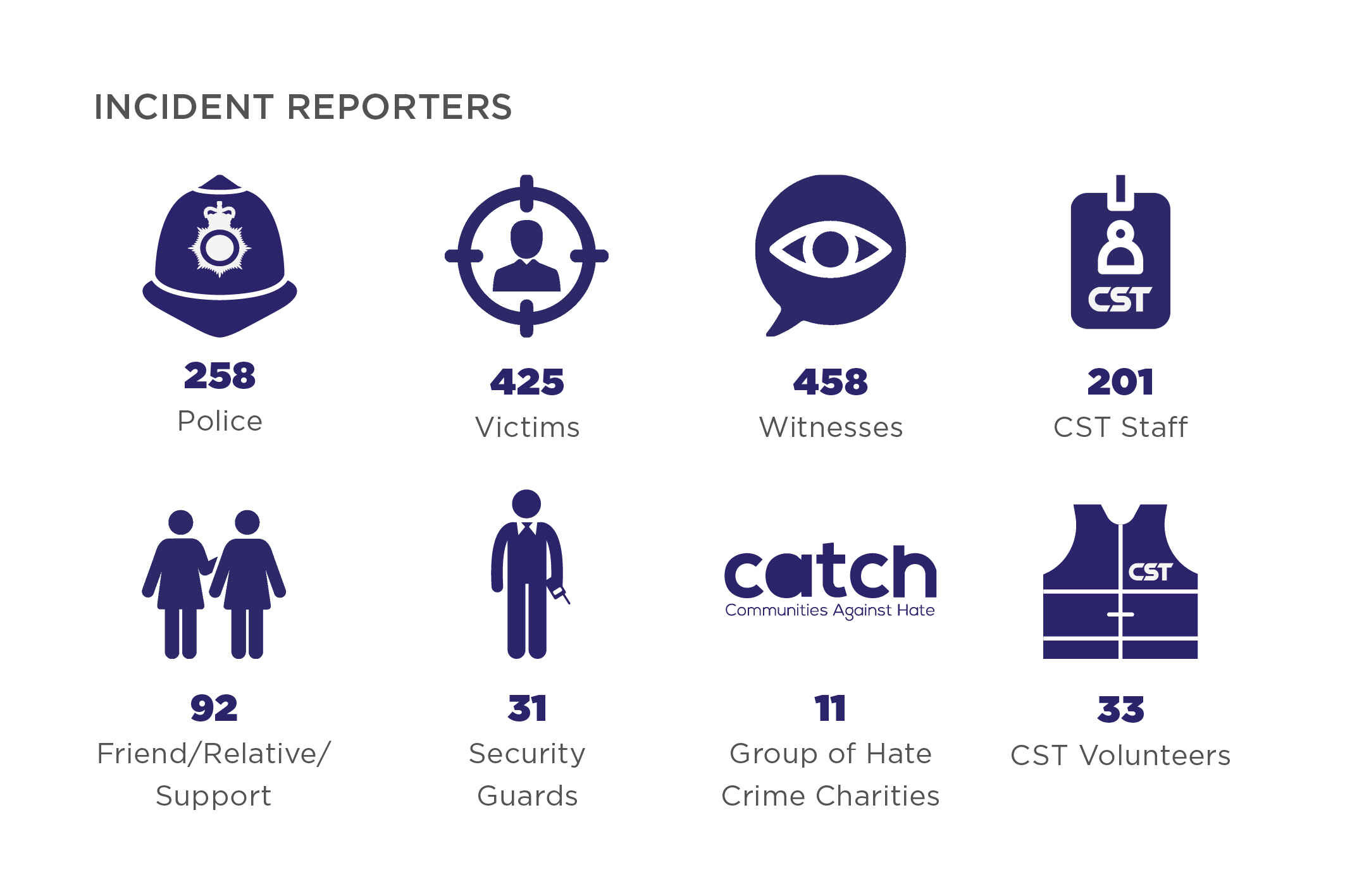
Antisemitic Incident Figures, January-June
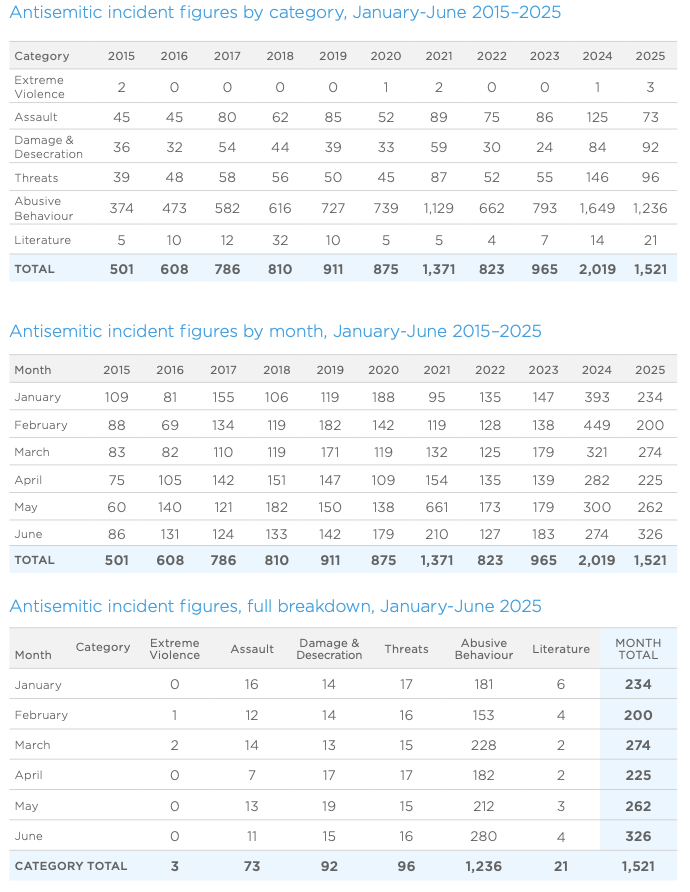

Footnotes
The incident totals for past years and months in this report may differ from those previously published by CST, due to the late reporting of some incidents to CST by incident victims, witnesses or other sources. Figures published in this report are also subject to change for the same reason.
Starmer criticises ‘appalling’ Bob Vylan IDF chants - BBC News
IDF Takes Control of Areas in Gaza Ahead of Expanded Ground Operation - Israel News
CST will ask incident victims or witnesses if they can describe the person, or people, who committed the incident they are reporting. Interactions between perpetrators and victims may be crude and brief, leaving little reliable information, and while it is often possible to receive reports regarding the apparent appearance or motivation of incident offenders, this is not absolute proof of the offenders’ actual ethnic or religious identity, nor of their motivation. In addition, many incidents do not involve face-to-face contact between offender and victim, so there is no physical description of the offender. With these caveats, CST does provide data regarding the ethnic appearance, age and gender of incident offenders.
Scotland is treated as a single geographical area due to Police Scotland being a single police service, but any comparisons of the incident total for Scotland with other much smaller geographical regions should be made with caution.
The Israel-Iran war by the numbers, after 12 days of fighting - The Times of Israel
Dramatic day ushers in a fragile Israel-Hamas ceasefire, ending 15 months of war - BBC News
A full explanation of CST’s antisemitic incident categories can be found in the leaflet Categories of Antisemitic Incidents
These 31 incidents include five attacks where mixed groups of adults and minors were targeted.
This figure includes bomb threats sent to multiple Jewish locations around the country simultaneously, which CST counts as a single incident.
All 12 incidents were online. Hundreds of antisemitic comments were brought to CST’s attention, but CST logs coordinated campaigns of anti-Jewish harassment as a single incident, even if it involves multiple posts, in order to preserve the integrity of CST’s published figures.
The next highest daily total for antisemitic incidents targeting Jewish institutions was five.
Dramatic day ushers in a fragile Israel-Hamas ceasefire, ending 15 months of war - BBC News
The Israel-Iran war by the numbers, after 12 days of fighting - The Times of Israel